造山型金矿概念提出之前,金矿分类命名纷繁复杂,例如以金矿产出地区命名、以赋矿围岩命名、以成矿温度命名、以矿化样式命名(Groves et al., 1998; Poulsen et al., 2000; Morelli et al., 2007; Goldfarb and Groves, 2015)。研究发现,尽管存在不同的分类体系,这些金矿均与大洋板块俯冲和陆块拼贴有关,产在汇聚板块边界变质地体内部或者边缘受韧-脆性断裂构造控制,成矿流体主要含H2O-CO2-H2S,成矿深度在2~20km、温度在200~650℃及其相应的蚀变矿化组合随深度有较大变化(Gebre-Mariam et al., 1995; Groves et al., 1998, 2003; Kerrich et al., 2000a; Goldfarb et al., 2001, 2005; Goldfarb and Groves, 2015)。为了统一分类命名不同却具有诸多相似性的这一类矿床,Groves et al.(1998)将其命名为造山型金矿。自造山型金矿提出以来,这一分类术语得到广泛的应用(Kerrich et al., 2000a; Groves et al., 2003; Goldfarb et al., 2005; Goldfarb and Groves, 2015),是全球金勘查的重要类型,截至2019年其资源量占到全球金资源量的30%以上(Goldfarb et al., 2019)。
造山型金矿提出后,一直是矿床研究的热点,前人对于矿床成因和沉淀机制提出了很多理论模式和认识,包括“地壳变质流体成因模式”(Phillips and Powell, 2009, 2010, 2015; Tomkins and Grundy, 2009)、“构造体制转换成矿”(Deng et al., 2020)、“地壳连续成矿模式”(Groves et al., 1992; Groves,1993)、“地震泵降压成矿模式”(Weatherley and Henley, 2013)、“围岩氧化成矿模式”(William-Jones et al., 2009)以及“震间富集模式”(Voisey et al., 2020)。尽管存在上述重要进展,仍存在以下薄弱环节:(1)以往对造山型金矿床的研究多注重在大洋俯冲背景下、与俯冲作用同期的造山型金矿,对于大陆碰撞及复合造山背景下形成的造山型金矿研究尚不完善; (2)地壳连续成矿模式对区域上造山型金矿的矿化蚀变进行了系统的对比,而对于区域性造山型金矿同位素等地球化学特征缺乏系统对比和解释; (3)研究了岩石圈-成矿带-矿田不同尺度构造对于造山型金矿产出的控制(Hodgson, 1989; Cox, 1999; Cox et al., 2001; Bierlein et al., 2006),多尺度构造级联对于造山型金矿的控制仍有待深化,对于流体输运的驱动力仍没有明确; (4)流体物质来源存在幔源(Deng et al., 2015a; Kolb et al., 2015; Wang et al., 2019; Zhao et al., 2019)和壳源(Phillips and Powell, 2009, 2010, 2015; Tomkins and Grundy, 2009; Tomkins, 2010)的争议,对于幔源流体而言其物质输运介质是以岩浆还是流体为主的形式也存在争议(Wang et al., 2020a, b); (5)元素迁移的方式存在不同的机制,比如胶体金和配位金等(Voisey et al., 2020)。
青藏高原造山型金矿属于特提斯-喜马拉雅造山带成矿带的一部分。该成矿带造山型金矿主要分布在西部的Alps带、中部的Zagros带以及东部的青藏高原(图 1); Alps带成矿带多数形成于大陆伸展环境(Rauchenstein-Martinek et al., 2014),中部的Zagros带形成于大洋俯冲以及大陆初始碰撞阶段(Agard et al., 2011),而东部的青藏高原则涵盖其它两个成矿带的构造环境,具有代表性。青藏高原是地球上研究大陆碰撞相关成矿作用的天然实验室(Molnar et al., 1993; Chung et al., 2005; Yin, 2006; Wang et al., 2014a); 现有的对青藏高原地球物理探测(Zhang et al., 2014a; Guo et al., 2018; Jin et al., 2018)、岩石学与地球化学研究(Wang et al., 2008; Xu et al., 2010; Guan et al., 2012)和构造分析的结果(Quidelleur et al., 1997; Yin et al., 1999; Tobgay et al., 2012),为研究大陆碰撞背景下造山型金矿的成因提供了重要窗口。青藏高原大陆碰撞经历主碰撞陆陆汇聚、晚碰撞构造转换和后碰撞地壳伸展三个阶段(侯增谦等, 2006a, b, c),不同构造背景下形成的各类矿床均备受关注(侯增谦等, 2006d; Hou and Cook, 2009),例如斑岩型金-铜矿(Hou et al., 2003, 2006, 2009, 2013, 2015a, 2017; Yang et al., 2009a, 2015, 2016)、MVT型铅锌矿(邓军等, 2010; Deng et al., 2014a; Song et al., 2015, 2019; Liu et al., 2017)、碳酸盐岩型稀土矿(Hou and Cook, 2009; Hou et al., 2015b)等。此外,对大陆碰撞背景下造山型金矿的研究也取得了重要进展,如在成矿物质来源(Sun et al., 2009; Chen et al., 2014; 李华健等, 2017)、构造触发条件(Yang et al., 2009b; Zhai et al., 2014)和成矿构造背景(Wang et al., 2019)等方面都有诸多新认识。但这些研究多聚焦在单个矿带或者矿床尺度(Jiang et al., 2009; Sun et al., 2016; Cao et al., 2019; Li et al., 2019),本文着眼青藏高原雅鲁藏布江、哀牢山和喜马拉雅三条造山型金成矿带,从成矿省尺度出发,综述不同金矿带中金矿的矿床地质特征和控矿构造(图 2、图 3),揭示岩石圈演化和造山型金成矿之间的时空耦合联系(图 4、图 5),建立青藏高原碰撞背景“源-运-储”系统成矿模式,与典型增生背景造山型金矿对比,重点突出了大陆碰撞背景下造山型金矿的特色。

|
图 1 特提斯域新生代造山型金矿分布图(据宋玉财等, 2017; Goldfarb et al., 2001; Richards, 2015a; Moritz et al., 2006; Aliyari et al., 2012; Deng and Wang, 2016) Fig. 1 Distribution of Tethyan Cenozoic orogenic gold deposits (modified after Song et al., 2017; Goldfarb et al., 2001; Richards, 2015a; Moritz et al., 2006; Aliyari et al., 2012; Deng and Wang, 2016) |
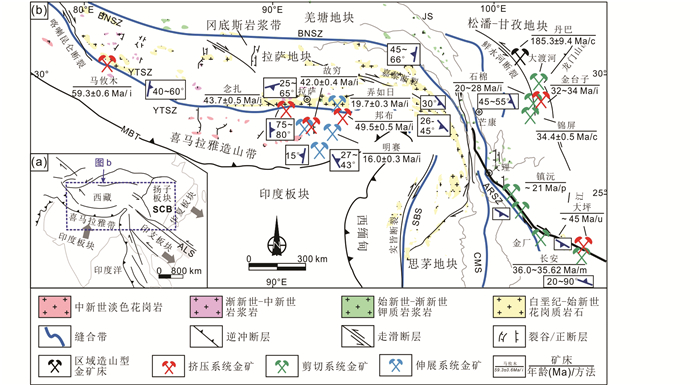
|
图 2 大地构造简图(a)及青藏高原地质背景和新生代造山型金矿分布图(b,据Chung et al., 2005修改) 矿床年龄据:Zhao et al. (2019), Deng et al. (2015c), Jiang et al. (2009), Pei et al. (2016), Zhang et al. (2020), Liu et al. (2019), 孙晓明等(2007), 张雄等(2018), 应汉龙和骆耀南(2007). ARSZ-哀牢山-红河剪切带; ASS-哀牢山剪切带; BNSZ-班公湖-怒江缝合带; CMS-昌宁-孟连缝合带; JS-金沙江缝合带; MBT-主边界逆断层; SBS-掸邦缝合带; YTSZ-雅鲁藏布江缝合带. i-绢云母Ar-Ar年龄; c-辉钼矿Re-Os年龄; q-石英Ar-Ar年龄; k-金云母Ar-Ar年龄; m-黑云母Ar-Ar年龄 Fig. 2 Simplified geotectonic map (a) and simplified geological map (b) of Tibet showing location of the major Cenozoic orogenic gold deposits (modified after Chung et al., 2005) Age of gold deposits from Zhao et al. (2019), Deng et al. (2015c), Jiang et al. (2009), Sun et al. (2016), Zhang et al. (2020), Liu et al. (2019), Sun et al. (2007), Zhang et al. (2018), Ying and Luo (2007). ARSZ-Ailaoshan-Red River Shear Zone; ASS-Ailaoshan Suture; BNSZ-Bangong-Nujiang Suture Zone; CMS-Changning-Menglian Suture; JS-Jinshajiang Suture; MBT-Main Boundary Thrust; SBS-Shan Boundary Suture; YTSZ-Yalung Tsangpo Suture Zone. i-sericite Ar-Ar age; c- molybdenite Re-Os age; q-quartz Ar-Ar age; k-phlogopite Ar-Ar age; m-biotite Ar-Ar age |
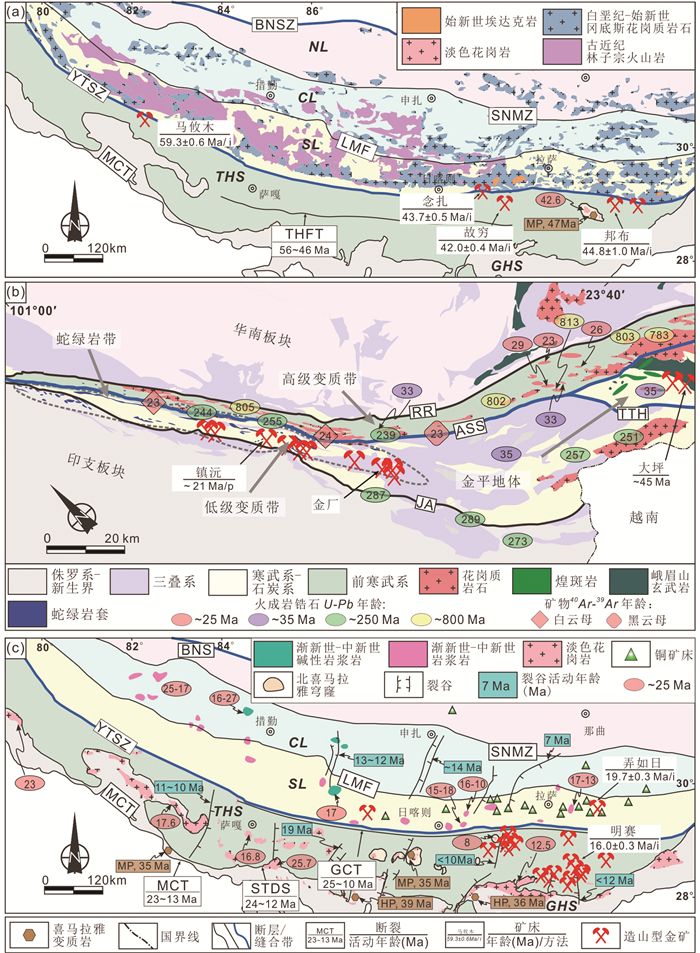
|
图 3 青藏高原及哀牢山地区金矿分布和地质简图 (a)拉萨地块和喜马拉雅带挤压系统造山型金矿以及岩浆岩分布图(据Guan et al., 2012; Ji et al., 2012; Wang et al., 2010, 2014a; Hu et al., 2016修改); (b)哀牢山成矿带剪切系统造山型金矿及岩浆岩分布图(据Wang et al., 2014b, 2020修改); (c)伸展系统造山型金矿及渐新世-中新世岩浆岩、变质岩和裂谷分布图(据Huang et al., 2017; Wang et al., 2010; Ding et al., 2016修改).岩浆岩年龄据李龚健等(2013), Fan et al. (2010), Lin et al. (2012), Cai et al. (2014), Lai et al. (2014), Liu et al.(2015a, b), Wang et al. (2016); 矿物40Ar/39Ar年龄来源于Cao et al. (2011); 断裂及裂谷年龄据Wang et al. (2014a); 金矿年龄来源同图 1. BNSZ-班公湖-怒江缝合带; CL-中拉萨地块; GHS-高喜马拉雅序列; LMF-洛巴堆-米拉山断裂; MCT-主中央逆断层; NL-北拉萨地块; SL-南拉萨地块; SNMZ-狮泉河-纳木错混杂岩带; STDS-藏南拆离系; THFT-特提斯喜马拉雅褶皱逆冲带; THS-特提斯喜马拉雅序列; YTSZ-雅鲁藏布江缝合带; ALS-哀牢山剪切带; JA-九甲-安定剪切带; RR-红河剪切带; TTH-藤条河剪切带. i-绢云母Ar-Ar年龄; u-未发表数据 Fig. 3 Simplified geological map showing the distribution of gold deposits in Tibet and Ailaoshan area (a) simplified geological map of the Lhasa terrane and Himalaya showing the location of gold deposits in transpressional system and magmatism in Lhasa terrane (modified after Guan et al., 2012; Ji et al., 2012; Wang et al., 2010, 2014a; Hu et al., 2016); (b) simplified geological map of the Ailaoshan metallogenic belt showing the location of gold deposits in shear system and magmatism (modified after Wang et al., 2014b); (c) simplified geological map showing the location of the major gold deposits in extensional system, Oligocene-Miocene magmatic rocks, metamorphic rocks and rifts (modified after Huang et al., 2017; Wang et al., 2010; Ding et al., 2016). Igneous zircon U-Pb ages from Li et al. (2013), Fan et al. (2010), Lin et al. (2012), Cai et al. (2014), Lai et al. (2014), Liu et al.(2015a, b), Wang et al. (2016); mineral 40Ar/39Ar ages from Cao et al. (2011); rift and fault age from Wang et al. (2014a). Sources of gold deposit ages see Fig. 1. BNSZ-Bangong-Nujiang Suture Zone; CL-Central Lhasa subterrane; GHS-Greater Himalayan Sequence; LMF-Luobadui-Milashan Fault; MCT-Main Central Thrust; NL-Northern Lhasa subterrane; SL-Southern Lhasa subterrane; SNMZ-Shiquanhe-Nam Tso Mélange Zone; STDS-South Tibetan Detachment System; THFT-Tethyan Himalaya Fold-Thrust Belt; THS-Tethyan Himalayan Sequence; YTSZ-Yalung Tsangpo Suture Zone; ALS-Ailaoshan shear zone; JA-Jiujia-Anding shear zone; RR-Red River shear zone; TTH-Tengtiaohe shear zone. i-Sericite Ar-Ar age; u-unpublished data |
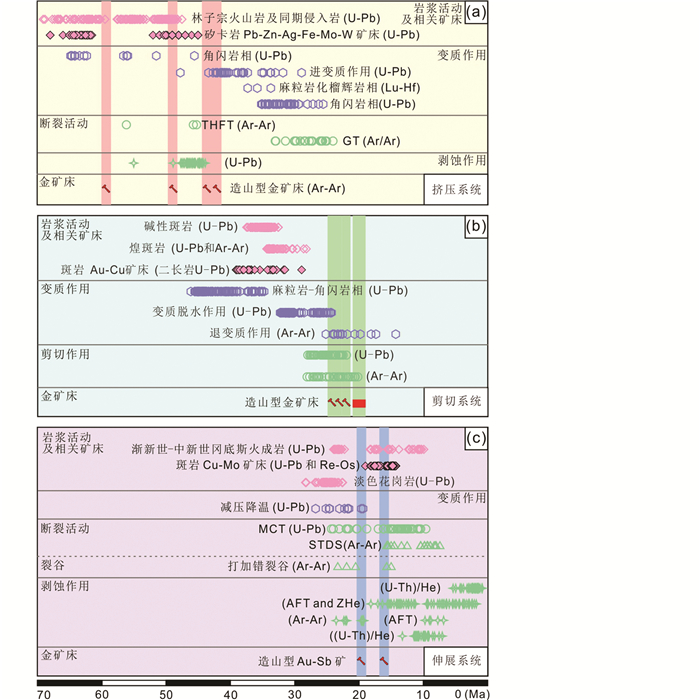
|
图 4 青藏高原造山型金矿带主要地质事件年代图 (a)挤压系统相关地质事件; (b)剪切系统相关地质事件; (c)伸展系统相关地质事件. GT-冈底斯逆冲断层; MCT-主中央逆断层; STDS-藏南拆离系; THFT-特提斯喜马拉雅褶皱逆冲带.数据来源:变质作用据Guo et al. (2012), Zhang et al. (2015), Iaccarino et al. (2015), Kellett et al. (2014); 断层据Tobgay et al. (2012); Harrison et al. (2000), Wiesmayr and Grasemann (2002); 斑岩型矿床据应立娟等(2010), 李光明等(2005); 矽卡岩型矿床据Zheng et al. (2015); 金矿床据Pei et al. (2016), 温春齐等(2004), Yang et al. (2009b); 裂谷据Williams et al. (2001); 抬升作用据Adams et al. (2009), Deeken et al. (2011), Lee et al. (2011) Fig. 4 Synthentic diagram showing all compiled ages of important geological events of the Tibet metallogenic belts (a) transpressional system; (b) shear system; and (c) extensional system. GT-Gangdese Thrust; MCT-Main Central Thrust; STDS-South Tibetan Detachment System; THFT-Tethyan Himalaya Fold-Thrust Belt. Data sources: Metamorphism from Guo et al. (2012), Zhang et al. (2015), Iaccarino et al. (2015), Kellett et al. (2014); faults from Tobgay et al. (2012), Harrison et al. (2000), Wiesmayr and Grasemann (2002); porphyry deposits from Ying et al. (2010), Li et al. (2005); skarn deposits from Zheng et al. (2015); gold deposits from Pei et al. (2016), Jiang et al. (2009), Yang et al. (2009b); rift from Williams et al. (2001); exhumation Adams et al. (2009), Deeken et al. (2011), Lee et al. (2011) |
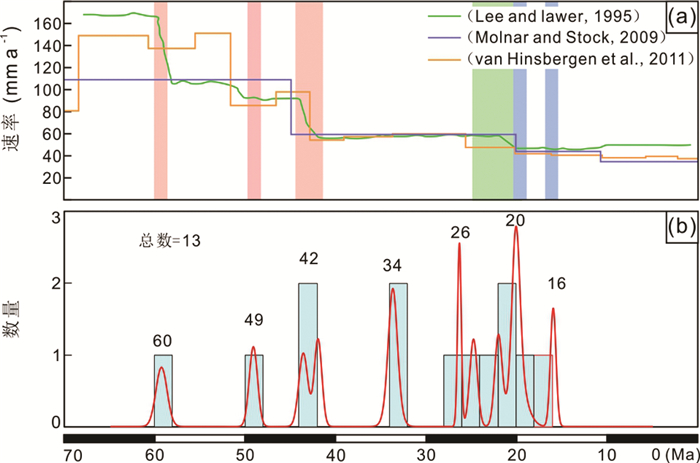
|
图 5 印度板块与欧亚板块会聚速率随时间变化折线图(a)及西藏造山型金矿年龄频率曲线(红色)和直方图(b) 印度板块漂移速率据Molnar and Stock (2009), Lee and Lawver (1995), Van Hinsbergen et al. (2011).矿床年龄据黄瀚霄等(2012), 张雄等(2018), 应汉龙和骆耀南(2007), 孙晓明等(2006), Jiang et al. (2009), Pei et al. (2016), Zhang et al. (2020), Liu et al. (2019), Wang et al. (2001) Fig. 5 Rate of convergence between India and Eurasia as a function of age (a) and histogram of mineralization ages (Ma) of orogenic gold deposits from Tibet (b) The red line represents the frequency curve. Convergence rate after Molnar and Stock (2009), Lee and Lawver (1995), Van Hinsbergen et al. (2011). Mineralization ages of orogenic deposits from Huang et al. (2012), Zhang et al. (2018), Ying and Luo (2007), Sun et al. (2006), Jiang et al. (2009), Pei et al. (2016), Zhang et al. (2020), Liu et al. (2019), Wang et al. (2001) |
研究表明造山型金矿形成于多元和复杂的构造背景,然而不同成矿背景造山型金矿成矿特征的区别和联系尚没有查明; 成矿过程中受到多尺度构造和流体作用的控制,不同尺度和类型成矿过程的级联不清; 成矿流体具有幔源和壳源等多种来源的可能性,不同来源在不同地区和背景造山型金矿的适用性需要进一步澄清。多元构造背景多尺度级联的造山型金矿成因机制仍是一个重要的前缘科学问题。需要从成矿省-矿集区-矿体-矿石与矿物的多尺度级联的研究视角出发,分别澄清造山型金矿成矿金属与流体来源-流体迁移构造格架-流体就位与水岩反应-流体相变与金属沉淀机制,系统揭示和深入认识成矿的多尺度和多因耦合机制。
1 构造单元和大陆演化古生代至中生代,由于古-中-新特提斯洋的相继闭合,造成冈瓦纳古陆的板块拼合,进而形成了青藏高原及其周边地区(Deng et al., 2014a; Wang et al., 2014b); 而后,新生代印度大陆与欧亚大陆碰撞,形成青藏高原大陆碰撞带,包括正向和斜向碰撞带。
大陆正向碰撞带中,青藏高原由拉萨、东羌塘和西羌塘三个地块组成(图 2); 而雅鲁藏布江缝合带(YTSZ)则代表着印度和欧亚大陆的会聚边界,由横跨不同纬度、宽约4000km的洋盆,被挤压至现在只有几百米到几十千米宽的狭窄地带(Hébert et al., 2012; Chan et al., 2015; Xu et al., 2015)。大陆正向碰撞过程中,在雅鲁藏布江缝合带南部形成喜马拉雅造山带。
在青藏高原东南缘的斜向大陆碰撞带,包含有滇缅泰马,印支和华南地块,依次由龙木措-双湖-昌宁-孟连缝合带和金沙江-哀牢山缝合带分割。在华南地块的西缘和北缘,新元古代汉南-攀西弧是由晚中元古代至早新元古代的变质地层和具有类弧地球化学特征的新元古代深成杂岩体组成(Zhou et al., 2006; Zhao et al., 2011)。在斜向大陆碰撞带中,特别是沿古特提斯哀牢山缝合带,在32~10Ma期间,斜向碰撞导致陆块发生旋转、挤出和剪切(Deng et al., 2015b)。
1.1 挤压系统在55~50Ma期间,印度大陆漂移至海沟标志着新特提斯洋闭合,印度大陆与欧亚大陆开始碰撞(Najman et al., 2010; Replumaz et al., 2014); 由于印度大陆和欧亚大陆之间的会聚速率相对喜马拉雅地区的缩短速率更快,从而导致青藏高原隆升(Doglioni et al., 2007)。在55~45Ma期间,新特提斯洋俯冲板片回撤在拉萨地块南部的弧带内诱发冈底斯岩基侵入和林子宗火山活动(图 4a; Chung et al., 2005, 2009; Ji et al., 2009; Xia et al., 2011; Liu et al., 2018)。在45Ma左右,大陆碰撞速度突然下降,标志着印度大陆与欧亚大陆从“软碰撞”向“硬碰撞”转变。与此同时,根据喜马拉雅带变质岩的记录,新特提斯洋板片与印度大陆岩石圈发生断离(DeCelles et al., 2002; Kohn and Parkinson, 2002)。
在晚始新世,随着印度大陆和欧亚大陆碰撞持续进行,双重褶皱和同时期的岩浆作用(约43Ma)导致拉萨地块南部和特提斯喜马拉雅带地壳增厚(Mo et al., 2007; Aikman et al., 2008; Zeng et al., 2011)。与此同时,喜马拉雅造山带还经历了广泛的变质作用(图 4a; Zeng et al., 2012; 张里和吴耀, 2012; Zhang et al., 2014c)。在喜马拉雅造山带的中部和东喜马拉雅结晶岩,经历了高压(HP)榴辉岩相变质作用(Liu and Zhong, 1997; Groppo et al., 2007; Guillot et al., 2008)或高压麻粒岩相变质作用(Ding and Zhong, 1999)。在晚始新世35~30Ma期间,南拉萨地块作为俯冲带上的加厚地壳,经历了与高喜马拉雅序列早期高压变质作用有关的中压(MP)角闪岩相变质作用。这两条同时期的HP和MP变质带作为成对变质带,代表着陆-陆碰撞后喜马拉雅型造山运动的特征(Zhang et al., 2010)。
1.2 剪切系统在青藏高原东缘印度-欧亚大陆斜向碰撞带,变质作用和地壳剪切作用均发生在先存剪切带上,其中最为显著的就是哀牢山-红河剪切带(Deng et al., 2014b, 2015b; Wang et al., 2014b, 2019)。哀牢山剪切带在44~36Ma期间经历了与地壳深熔作用有关的峰期角闪岩-麻粒岩相变质(图 4b; P-T条件为8.0~9.6kb,720~760℃; Schärer et al., 1990; Jolivet et al., 2001; Anczkiewicz et al., 2007; Searle et al., 2010; Liu et al., 2013, 2015a)。32~25Ma峰期变质之后为峰后近等温减压作用阶段(P-T条件为5.0~6.5kb,700~750℃),随后是25~20Ma晚期退变质阶段(P-T条件为4.0~4.5kb,520~620℃; Liu et al., 2013)。根据不同构造期次淡色花岗岩锆石U-Pb年龄可以得出,大规模的剪切位移发生在32~24Ma退变质过程中(Chung et al., 1997; Cao et al., 2011)。根据变形岩石中云母和角闪石Ar-Ar年龄,该地区地壳在23Ma发生抬升(未发表数据),结合独居石和磷钇矿U-Pb年龄(Schärer et al., 1990)可以证实,该地区退变质作用晚期还伴随着地壳深熔作用。
1.3 伸展系统在青藏高原南部,拉萨地块存在侵位年龄在25~10Ma之间,峰值年龄约为15Ma的埃达克质岩浆岩(图 3c),这些埃达克质岩浆岩可能与俯冲的印度大陆岩石圈板片发生回撤有关(Williams et al., 2001; Hou et al., 2015a),而深部板片发生回撤则会在地壳浅部诱发同期的水平伸展运动(Hou and Cook, 2009)。高Sr/Y超钾质岩石具有放射性Sr-Nd同位素特征和高εHf值(5~12),并且与中新世斑岩型Cu-Mo矿化相关(Hou et al., 2015a, c)。拉萨地块东部的岩浆岩侵入体与斑岩矿床具有广泛联系(图 3c、图 4c),而西部地区的岩浆活动则很少。拉萨地块东西部岩浆活动具有显著的差异性可能与东西部印度岩石圈俯冲角度不同有关(侯增谦等, 2006e; Guo et al., 2015, 2018)。藏南晚渐新世-中新世淡色花岗岩属于喜马拉雅造山带内东西走向、长约3000km的火成岩侵入区的一部分(Guo and Wilson, 2012)。这些侵入岩具有高Rb/Sr(>1.0)和高(87Sr/86Sr)i(>0.7300)比值,体现出来源于变质作用期间的变质泥岩熔融等特征(King et al., 2011; Tian et al., 2017)。
北喜马拉雅域地层以特提斯喜马拉雅序列(THS)为主(图 3c),伸展性构造包括藏南拆离系(STDS; Burg and Chen, 1984; Burchfiel et al., 1992)、北喜马拉雅片麻岩穹窿(NHGD)和南北走向裂谷(NSTR)。在喜马拉雅北部~92°E至~78°E范围内,NHGD呈带状分布(Burg et al., 1984; Hodges, 2000; Lee et al., 2004)。其中大部分穹窿的核部为年龄在10~35Ma之间的二云母花岗岩或淡色花岗岩。这些侵入岩外围是发生了变形的片麻岩,U-Pb年龄约为500Ma,最外侧是变质程度较低的特提斯喜马拉雅序列(Zhang et al., 2004; Aoya et al., 2005; Lee et al., 2006; Quigley et al., 2006; Lee and Whitehouse, 2007)。变质核杂岩与外覆THS被北倾的拆离剪切带分隔,呈断层接触(Chen et al., 1990; Burchfiel et al., 1992; Hodges, 2000; Aoya et al., 2005, 2006; Lee et al., 2006),这些北倾的拆离剪切带可能为被剥露的藏南拆离系(Zhang and Guo, 2007)。在喜马拉雅山造山带,一系列南北走向的裂谷垂直于造山带的走向分布,反映了东西向的伸展运动。这些裂谷包括Leo Pargil、GularMandhata、Thakkola、Kung Co和Ama DrimeMassif(Murphy et al., 2002; Hintersberger et al., 2010; Mitsuishi et al., 2012)。根据构造与地质体之间的切割关系,这些东西向伸展构造切割了所有先存的变形组构,包括较老的、与造山带平行的正断层。
2 金矿带的时空分布和成矿背景青藏高原地区新生代大规模构造演化分别沿雅鲁藏布江缝合带、哀牢山剪切带和喜马拉雅造山带形成了三个重要的金矿带(图 2),根据控矿构造和地质特征,这三个金矿带分别处于挤压、剪切和伸展构造系统中(表 1)。金成矿作用发生在峰期变质和退变质之后(图 4),从现有的成矿时代分析,三个成矿带金矿集中成矿时期对应于印度和欧亚大陆碰撞速率发生急速下降期(图 5; Lee and Lawver, 1995; Molnar and Stock, 2009; Van Hinsbergen et al., 2011)。
|
|
表 1 青藏高原新生代造山型金矿床地质特征 Table 1 Geological features of the Cenozoic orogenic gold deposits in Tibet |
形成于挤压系统中的造山型金矿超过200t金(温春齐等, 2004, 2006; Sun et al., 2016; Zhang et al., 2018; 张雄等, 2018),沿着雅鲁藏布江缝合带分布,其中以马攸木、念扎、邦布和折木朗金矿最为典型(图 3a)。该带中赋矿地层主要为三叠系浅变质岩和新元古界-寒武系片岩(表 1、图 6),成矿年龄和区域主碰撞构造事件时间一致(侯增谦等, 2006c, e),和区域进变质作用同期(图 4a)。马攸木金矿床位于雅鲁藏布江缝合带西段,根据与含金石英脉有关的蚀变绢云母40Ar/39Ar测年判断,金矿大约形成于59Ma(Jiang et al., 2009)。念扎金矿床位于雅鲁藏布江缝合带南侧仁布构造混合岩带中,绢云母40Ar/39Ar年龄显示金成矿事件发生在约45Ma(张雄等, 2018)。邦布金矿床位于雅鲁藏布江缝合带东段南侧三叠系朗杰学群增生楔中,热液绢云母40Ar/39Ar年龄显示金矿化形成于49Ma左右(Pei et al., 2016)。
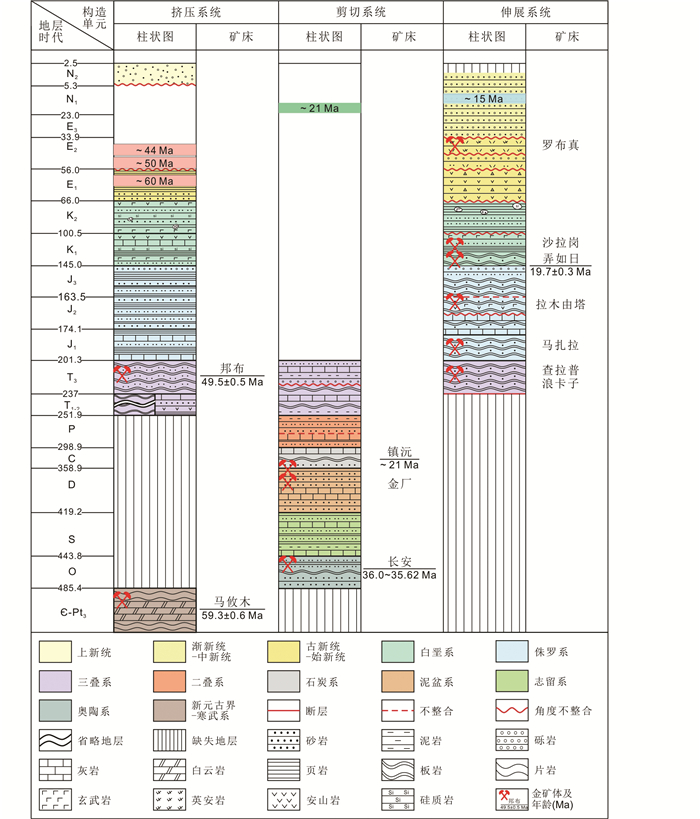
|
图 6 青藏高原成矿带三大造山型金矿成矿带地层柱状图(据霍艳, 2005; 刘云飞, 2013; 杜泽忠, 2011; 张刚阳, 2012; 黄瀚霄等, 2012, 2018; Wang et al., 2019; Jiang et al., 2009; Pei et al., 2016修改) Fig. 6 Stratigraphic columns of three orogenic gold belts in Tibet (modified after Huo, 2005; Liu, 2013; Du, 2011; Zhang, 2012; Huang, 2012 2018; Wang et al., 2019; Jiang et al., 2009; Pei et al., 2016) |
与哀牢山剪切带伴生的哀牢山造山型金成矿带主要包括镇沅、金厂和长安三个大型造山型金矿床(图 3b)以及超过30个小型矿床(Zhang et al., 2014b)。镇沅金矿蚀变煌斑岩热液铬水云母Ar-Ar测年结果表明,哀牢山金矿带金矿化主要发生在约32~26Ma(Deng et al., 2015c)。剪切前渐新世富碱斑岩(~ 34Ma; Zhang et al., 2014b)和煌斑岩(34~30Ma; Wang et al., 2001)侵入体发育了与金矿相关的围岩蚀变组合,表明哀牢山与剪切带有关的金矿形成于钾质岩浆作用之后(Guo et al., 2005; Sun et al., 2009; Chen et al., 2014; Zhang et al., 2014b)。另外最近的古地磁研究显示金矿化发生在21Ma,即发生在哀牢山剪切带大规模左旋剪切之后,很可能是处于韧脆性变形的转换阶段(Gao et al., 2018)。该带中赋矿岩石主要为奥陶系到石炭系的浅变质岩和碎屑岩以及超镁铁质岩石(图 6),金成矿形成于晚碰撞阶段(侯增谦等, 2006a),与区域退变质作用时间一致(图 4b)。
扬子克拉通西北缘与松潘-甘孜增生杂岩体和义敦岛弧南部相邻,大渡河、石棉、锦屏山等许多分布于此的造山型金矿与新生代区域走滑断裂有关(Deng and Wang, 2016)。应汉龙和骆耀南(2007)测定了石棉矿区中瓦斯沟、黄水沟、大岩房、金洞子和金台子五个矿床中的蚀变白云母40Ar/39Ar坪年龄,分别为约22Ma、25~28Ma、20Ma、20Ma和32~34Ma。锦屏山矿区的赋矿围岩主要为晚元古代结晶灰岩和白云石化灰岩,含金矿脉的绢云母40Ar/39Ar年龄为23Ma(Deng and Wang, 2016)。
2.3 伸展系统喜马拉雅造山带北部存在一条北部以雅鲁藏布江缝合带为界,南部以藏南拆离系为界的金-锑成矿带,成矿带内先后发现超过50个金和金-锑矿床和矿点(聂凤军等, 2005),典型矿床由西向东分别有布主金矿、沙拉岗锑矿、马扎拉金锑矿和明赛金矿。该带中赋矿地层主要为三叠系到白垩系的浅变质岩和碎屑岩(图 6)。这些矿床与广泛分布的以中新世淡色花岗岩为核部的穹窿和南北向断裂存在密切的空间联系(图 3c)。由于藏南地区金-锑矿床缺乏合适的定年矿物,难以精确厘定成矿时代,但根据区域构造和控矿构造可限定金矿化时代为中新世(Yang et al., 2009b); 另外最新报道了金矿化的年龄为16Ma左右的明赛金矿(Zhang et al., 2020)。该带成矿年龄和区域后碰撞地质事件年龄一致(侯增谦等, 2006b),和退变质作用和穹隆的快速隆升同期(图 4c)。
3 矿床地质和成矿模型 3.1 挤压系统邦布金矿床位于近东西走向区域大型脆-韧性剪切带中段(图 7a),区内出露地层为三叠系绿片岩,沿断裂分布有少量的基性岩脉(图 7b)。金矿体赋存于上三叠统朗杰学群变质沉积岩中,岩性主要为海相硅质板岩、黑色碳质绢云千枚岩和杂砂岩等,大多呈低级绿片岩相变质(图 6)。矿体以含金石英脉形式产出,受区域脆-韧性剪切带次级NNW和NEE向断裂系控制(图 7b)。围岩蚀变主要有硅化、绢云母化和碳酸盐化等。
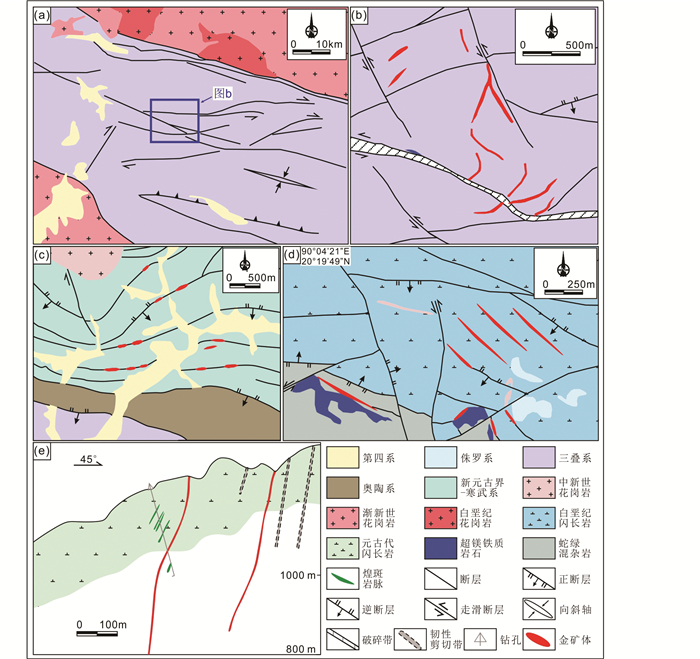
|
图 7 青藏高原挤压系统典型造山型金矿地质图 (a、b)邦布金矿(据Pei et al., 2016修改);(c)马攸木金矿矿床地质图(据Jiang et al., 2009修改);(d)念扎金矿矿床地质图(据李应栩等, 2019修改);(e)大坪金矿矿床剖面图(据Sun et al., 2009修改) Fig. 7 Simplified geological maps of typical orogenic gold deposits in compressional shear system, Tibet (a, b) the Bangbu gold deposit (modified after Pei et al., 2016); (c) the Mayum gold deposit (modified after Jiang et al., 2009); (d) the Nianzha gold deposit (modified after Li et al., 2019); (e) the cross section of the Daping gold deposit (modified after Sun et al., 2009) |
马攸木金矿床为大型金矿床,赋矿围岩主要为新元古界-寒武系绿片岩和细晶灰岩(图 6)。矿区内发育一系列近东西走向逆断层,被后期南北向和北北东向断层切割。矿体受近东西向断裂控制,呈透镜状、脉状和似层状(图 7c)。矿体周围发育有较强的围岩蚀变,主要有硫化、硅化、绢云母化、碳酸盐化和泥化。金矿化强度和硅化强度呈正相关(温春齐等, 2006)。
念扎金矿床南部出露三叠系增生楔,岩性主要为砂质板岩、变质砂岩、灰岩、大理岩等。矿区北部由于强烈的岩浆活动,广泛分布白垩纪石英闪长岩,局部见辉绿岩、辉长岩等基性岩脉。区内主要发育近EW向以及NE、NW向断裂,断裂性质以逆断层为主(图 7d)。高品位金矿化伴随硅化主要产于三叠系地层与白垩系侵入体NW向断层接触带附近,矿体产状受断裂控制。沿NW向断层发育有强烈的热液蚀变,包括绢云母化、硅化、碳酸盐化、褐铁矿化等,基性围岩还发育有蛇纹石化、绿泥石化等蚀变。
大坪金矿床(~45Ma; 未发表数据)位于哀牢山成矿带东南部,其和位于扬子板块西北缘的金台子(形成于~32Ma)一样(图 2b; 应汉龙和骆耀南, 2007),因为其形成时代比哀牢山剪切活动(21~27Ma; Schärer et al., 1994; Leloup et al., 2001; Cao et al., 2011)要早,所以归为了挤压系统内。大坪金矿金资源量>70t,平均品位为14.3g/t(杨立强等,2010)。围岩为新元古代闪长岩,奥陶系砂岩、粉砂岩和板岩。大多数含金矿脉约NW走向,倾向SW,倾角50°~80°(图 7e)。矿体产状指示矿化与区域NW向断裂具有一定的空间联系。矿体周围具有蚀变分带现象,闪长岩中的矿体形成的分别为近端石英-绢云母带,中部绿泥石-绿帘石带和远端碳酸盐岩-钠长石带。
3.2 剪切系统镇沅金矿由老王寨和冬瓜林两个矿区组成,是带内最大的金矿床,金储量>160t,平均品位5.3g/t(杨立强等, 2010)。该矿床位于蛇绿岩带北部,以复杂的围岩岩性为特征,其中包括上泥盆统变质石英砂岩、泥盆纪至石炭纪蛇绿岩、石炭系碳质板岩、二叠-三叠纪石英斑岩、上三叠统粉砂岩和始新世煌斑岩(图 6; Deng et al., 2015c)。构造对矿化控制体现在冬瓜林矿区以断层、褶皱和剪切节理组合以及陡立的NW向断层为主,老王寨矿区则以近东西向至北东向断层为主(图 8a; Deng et al., 2015c)。在冬瓜林矿区,上泥盆统变质石英砂岩与石炭系碳质板岩呈断层接触,受剪切的煌斑岩岩脉沿近平行的北西向陡倾断裂断续分布。老王寨矿区地层岩性为强烈劈理化的石炭系碳质板岩、泥盆纪超镁铁岩和上三叠统红粉砂岩。矿区内早古生代地层被石英花岗岩侵入,锆石U-Pb年龄为255~247Ma,在金矿化过程中,石英斑岩被成矿热液蚀变(李龚健等, 2013)。镇沅金矿赋矿围岩种类多样,但均发育有类似的蚀变组合,蚀变类型包括碳酸盐化(主要为白云石和铁白云石)、绢云母化和硫化。煌斑岩和花岗岩中的金云母和黑云母的斑晶已分别蚀变为铬云母和绢云母,沿解理分布有金红石和磷灰石的微晶(Li et al., 2019)。细粒浸染型富砷黄铁矿是主要的含金矿物,与绢云母蚀变伴生或在板岩、煌斑岩中围绕早期磁铁矿和沉积黄铁矿沉淀,同时还伴生少量毒砂、辉锑矿、黄铜矿和闪锌矿。
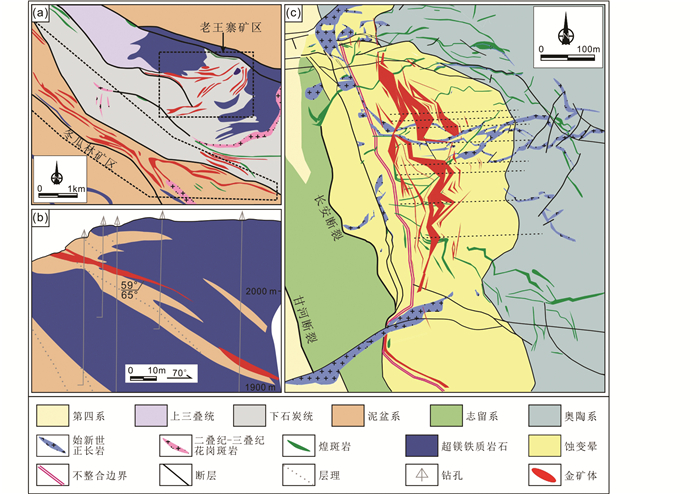
|
图 8 哀牢山剪切系统典型造山型金矿地质图 (a)镇沅金矿(据Wang et al., 2019); (b)金厂金矿矿床剖面图(据应汉龙等, 2005); (c)长安金矿矿床地质图(据Zhang et al., 2014b) Fig. 8 Simplified geological maps of typical orogenic gold deposits in Ailaoshan shear system (a) the Zhenyuan gold deposit (modified after Wang et al., 2019); (b) cross section of the Jinchang gold deposit (modified after Ying et al., 2005); (c) the Chang'an gold deposit (modified after Zhang et al., 2014b) |
金厂矿床具有独特的金-镍共生组合,赋存超过80t金,平均品位2.69g/t(Fang et al., 2001)。赋矿围岩主要为下-中泥盆统变质砂岩与板岩互层(图 6),广泛出露的上三叠统砂岩以及化蛇绿岩。蛇绿岩中辉石橄榄岩和纯橄岩已完全发生蛇纹化(熊伊曲等, 2015)。西北向分布的花岗质岩石和始新世煌斑岩岩脉侵入在泥盆系-三叠系的变质沉积岩和蛇绿岩中。金成矿作用形成于区域倒转褶皱核部的泥盆系砂岩和蛇绿岩中(图 8b)。金、镍矿体在该矿床中均有发育,空间上有少量重叠(Ying et al., 2001; 熊伊曲等, 2015)。在泥盆系变质岩和蛇绿岩中发育与金矿化有关的热液蚀变为类似的碳酸盐化、绢云母化、铬水云母化和硅化。在泥盆系板岩中,金以自然金的形式赋存在NW-SE向石英脉中,在蚀变砂岩和超镁铁质岩石中以不可见金形式赋存于砷黄铁矿和毒砂中(Ying et al., 2001)。
长安金矿床位于金平地体西部,含金110余吨,平均品位5.84 g/t(杨立强等, 2010)。该矿区出露的岩石主要为下奥陶统变质细粒石英砂岩和石英砾岩(图 6)、中-晚期志留系白云岩和第四系砾石(Zhang et al., 2014b)。奥陶系砂岩和砾岩为主要的赋矿岩石,呈近东西向分布,倾向北。矿床位于区域向斜翼部与区域北西向长安断裂结合部位,局部与矿区内志留系与奥陶系的不整合面重叠(图 8c)。沿长安断裂发育一条60~280m宽的破碎蚀变带,断裂上盘为圈闭的金矿体。蚀变主要包括硅化、绢云母化和碳酸化。绢云母化与金矿化密切相关,正长岩中的黑云母斑晶蚀变为绢云母。硫化物矿物以高砷黄铁矿、毒砂、方铅矿、黄铜矿、闪锌矿和黝铜矿为主(Zhang et al., 2014b)。浸染状砷黄铁矿一般赋存有不可见金和少量银金矿。
大渡河金矿位于大渡河两岸,赋矿围岩为太古代至早元古代的康定杂岩、元古代的石英闪长岩、花岗岩及闪长岩、新生代的基性岩脉。近南北向的脆性断裂控制着含金石英脉的分布(Li et al., 2007)。矿床含金石英脉中的白云母40Ar/39Ar坪年龄为24.7±0.3Ma(Deng and Wang, 2016)。石棉矿区位于大水沟穹隆东部,穹隆核部为大水沟岩浆核杂岩(图 9),主要岩性为变质碎屑岩和碳酸盐岩夹基性火山岩(张海, 2011)。该岩浆核杂岩经历多期变形变质作用,由内到外可划分为韧性剪切变形-铁铝榴石带、韧性剪切固态流动褶皱变形-黑云母带和弱剪切变形-绢云母绿泥石带(喻安光, 2000)。矿区赋矿围岩主要为元古代石英闪长岩、泥盆系碳酸盐岩和中生代石英斑岩(王小春, 1999)。
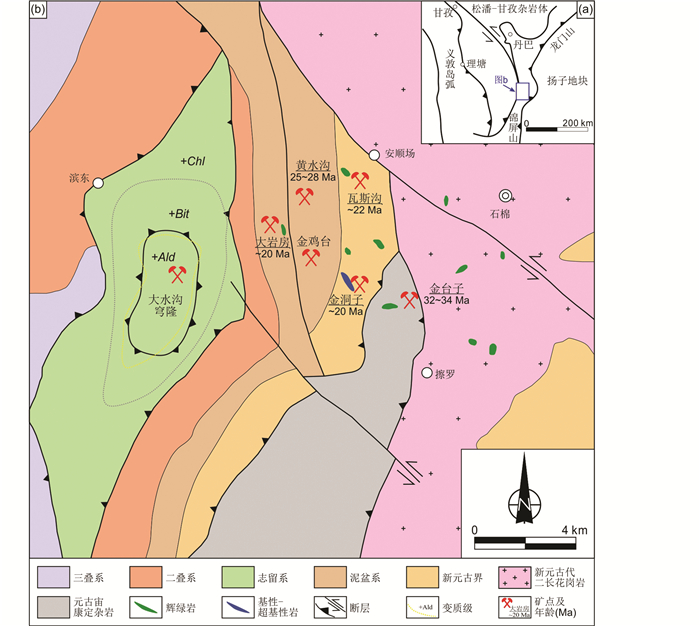
|
图 9 扬子西缘石棉矿区地质背景和金矿分布图(据应汉龙和骆耀南, 2007修改) Ald-铁铝榴石带;Bit-黑云母带;Chl-绿泥石带 Fig. 9 Simplified geological map of Shimian district in the western margin of Yangtze Craton showing the distribution of gold deposits (modified after Ying and Luo, 2007) Ald-almandine zone; Bit-biotite zone; Chl-chlorite zone |
形成于伸展系统的金矿床数量众多,至少有50t金以及0.01Mt锑(Zhai et al., 2014)。金矿多与锑矿床矿点共生,金、锑矿为同一个造山型成矿系统,从而本文放一起描述和研究。这些矿床的围岩主要为侏罗纪沉积岩、白垩纪碎屑岩、古新世和中新世花岗岩类。金矿化主要发生在含金辉锑矿-石英脉中以及浸染状蚀变岩中。矿体主要受北东向、北西向和东西向断裂控制(图 10)。矿体周围发育的热液蚀变包括硫化、硅化、绢云母化和碳酸化。
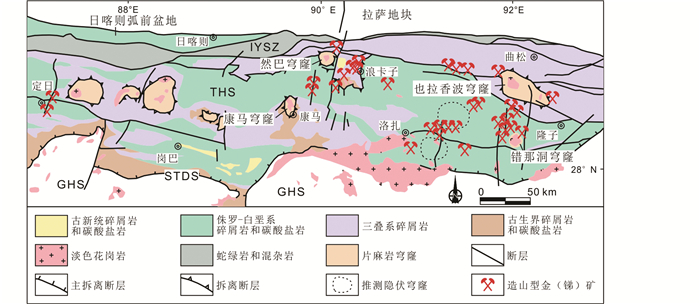
|
图 10 特提斯喜马拉雅伸展系统造山型金矿、片麻岩穹窿、淡色花岗岩分布图(据Yang et al., 2009b修改) Fig. 10 Simplified geological map of Tethyan Himalaya showing the distribution of orogenic gold deposits, gneiss domes and leucogranites in extensional system (modified after Yang et al., 2009b) |
明赛金矿是新发现的金矿床,平均品位为4g/t,具有较大的找金潜力(吴昊等, 2017)。矿床位于特提斯喜马拉雅层序东段,北邻也拉香波穹窿,南邻错那洞穹窿。金矿体赋存于EW向展布,北倾的侏罗系泥质、硅质沉积岩和凝灰岩夹层中,以凝灰岩夹层为主(图 11a)。该矿床的矿化类型包括以石英脉为主的硅化作用以及绢云母化作用。
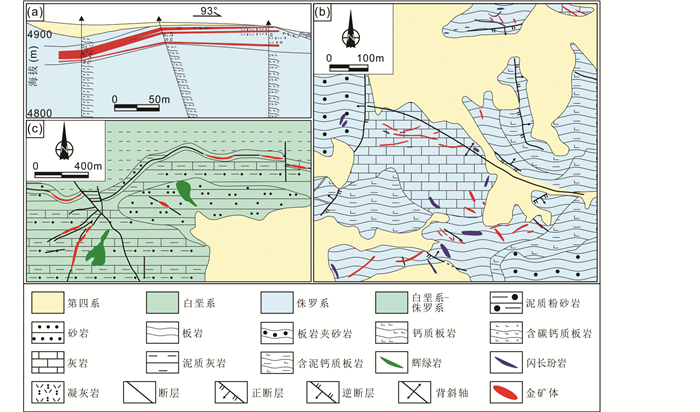
|
图 11 青藏高原伸展系统典型造山型金矿地质图 (a)明赛金矿剖面图(据Zhang et al., 2020修改); (b)马扎拉金矿矿床地质图(据张建芳等, 2011修改); (c)沙拉岗锑矿矿床地质图(据Zhai et al., 2014修改) Fig. 11 Geological maps of the typical orogenic gold deposits in the extensional system, Tibet (a) the cross section of Mingsai gold deposit (modified after Zhang et al., 2020); (b) the geological map of Malazha gold deposit (modified after Zhang et al., 2011); (c) the geological map of Shalagang antimony deposit (modified after Zhai et al., 2014) |
马扎拉金锑矿是一个小型矿床,金资源量 < 5t(Zhai et al., 2014)。矿床位于藏南特提斯喜马拉雅带。矿体围岩为下-中侏罗统板岩夹变质砂岩、变质粉砂岩和灰岩(图 6)。含金辉锑矿-石英脉矿体受北西、北东和东西向拆离断层控制(图 11b)。石英脉矿体中的矿石矿物主要为明金、辉锑矿、黄铁矿、褐铁矿和毒砂。自然金主要以包裹体的形式出现在石英和硫化物中或矿物颗粒间隙、裂隙中。围岩蚀变包括硅化、碳酸盐化、硫化、绢云母化和绿泥石化。
沙拉岗为一处中型锑矿床,锑资源量为0.01~0.1Mt,矿床位于然巴穹窿和康马穹窿之间。区域地层岩性为白垩系砂岩、粉砂岩、灰岩夹泥岩(图 6)。区内发育有两处小型的喜马拉雅期辉绿岩和闪长岩侵入体。已识别出的12个矿体均受EW向断层控制(图 11c)。矿化形式以角砾岩和网脉状的辉锑矿-石英脉为主。矿石矿物有辉锑矿、辰砂、锑华以及少量的黄铁矿、毒砂和雄黄。热液蚀变类型与围岩岩性具有一定的关联,硅化和硫化通常发育在围岩地层中,碳酸盐化和绿泥石化更倾向于发育在靠近矿化断裂的辉绿岩和闪长岩中。
3.4 连续成矿模型形成于不同构造背景中的矿床其矿化作用具有系统性的过渡转变:
(1) 挤压构造背景下形成的矿床矿化特征为以石英脉型矿体为主; 矿体产状可以陡倾也可以是缓倾; 围绕矿体的蚀变范围较窄; 主要矿石矿物为自然金和银金矿。代表性矿床为大坪金矿和邦布金矿(图 12a,b),其中,大坪金矿赋存于晚元古代闪长岩中,金与多金属硫化物形成于高角度石英脉中; 石英脉的两侧与围岩接触处发育黄铁矿,方铅矿矿化。邦布金矿赋存于晚三叠系碳质板岩中,矿区内部褶皱较为发育,受区域构造改造地层发育倾角较为平缓的劈理,金矿体赋存在受断裂控制的石英脉中,多期成矿作用形成多条含矿黑色条带。黄铁矿化形成于石英脉与围岩接触处。在韧性剪切带上脆性构造中发育的矿体存在多种破裂-愈合构造,这种现象或许可以用地震泵模式解释。众多学者观察到成矿流体具有不混相性,表明成矿流体从静岩压力环境转移到静水压力环境,引起流体压力的突然下降,从而导致金属沉淀(Weatherley and Henley, 2013; Peterson and Mavrogenes, 2014; Yamaguchi et al., 2018)。

|
图 12 青藏高原及周缘地区新生代造山型金矿地壳连续成矿模式图 (a)大坪金矿发育在新元古代闪长岩中,石英脉中发育黄铁矿-方铅矿-闪锌矿-自然金矿物组合;(b)邦布金矿围岩为发育S-C组构的三叠纪板岩。石英脉发育破裂-愈合构造,硫化物和金集中沉淀在石英脉内;(c)镇沅金矿为蚀变浸染型金矿,围岩条件复杂。蚀变煌斑岩中发育绢云母-碳酸盐-黄铁矿蚀变;(d)穹隆构造使区域近水平劈理带和近垂直断裂带发育,控制了明赛,马扎拉等一系列金锑矿床的矿化。明赛金矿围岩为侏罗系板岩发育一组近水平片理,并被后期方解石脉切割,含金硫化物沿劈理发育.Cb-碳酸盐矿物;Dol-白云石;Fs-铬水云母;Gn-方铅矿;Py-黄铁矿;Q-石英;Rt-金红石;Ser-绢云母 Fig. 12 Crustal continuum model for the Cenozoic orogenic gold deposits in Tibet and surrounding region (a)the Daping deposit is hosted in Late Proterozoic diorites. Quartz veins develop pyrite-galena-spherite-native gold assembly.(b)the Bangbu gold deposit is hosted in Late Triassic slate with S-C foliation. Sulfide and gold mainly occur within the laminated quartz vein.(c)The Zhenyuan deposit is hosted in altered county rocks with various lithologies. Altered lamprophyre developed sericite-carbonate-pyrite mineral assemblages.(d)Crustal doming result in the development of regional sub-horizontal foliation zone and vertical faults which controlled the location of gold mineralization. The Mingsai gold deposit is hosted in Jurassic slate with sub-horizonatal foliation cut by late carbonate vein. Au-bearing sulfide developed along the foliation. Cb-carbonate; Dol-dolomite; Fs-fuchsite; Gn-galena; Py-pyrite; Q-quartz; Rt-rutile; Ser-sericite |
(2) 与剪切带有关的矿床矿化特征为以浸染型矿化为主,金赋存于黄铁矿和毒砂晶格中,在陡倾破碎带内具有宽阔的蚀变晕。代表性矿床如镇沅、金厂和长安金矿(图 12c),由多种围岩类型发生蚀变形成矿体,矿体主要受控于顺层断裂或节理; 煌斑岩中金云母斑晶蚀变成绿色的铬水云母,长英质岩石中的黑云母和金云母被绢云母、黄铁矿和铁白云石交代,变质岩中的方解石蚀变为铁白云石或白云石,白云母蚀变为绢云母。含金黄铁矿普遍具有振荡环带,暗示在流体成分在成矿过程中发生改变(Li et al., 2019)。
(3) 伸展环境内穹隆构造使区域褶皱构造发育,在穹隆顶部和两侧形成明赛、马扎拉等一系列金锑矿床(图 12d),明赛金矿成矿岩性主要为侏罗纪凝灰岩。近水平裂隙中存在浸染状矿化,而在陡倾破碎带中存在细脉状矿化,蚀变带通常较窄,发育绢云母-碳酸盐-绿泥石-黄铁矿蚀变矿物组合。矿体小而富,数量众多而分布比较分散。金主要以自然金形式出现,多与后期的Sb矿化相伴生。
4 流体特征和同位素组成 4.1 流体特征和温压条件挤压构造系统的造山型金矿中成矿流体特征较为一致,包裹体类型以含CO2三相水溶液型和富液相两相水溶液型为主,含有少量纯CO2型和含有机质型(图 13a,b)。流体包裹体丰度较高,体积较大,长径多为5~15μm,少数可达到20~30μm,产状以小群和离散为主。成矿流体气相组分以CO2和H2O为主,同时含有少量有机质与CO、N2和H2S等还原性气体。CO2体积百分数多分布于0.1~0.5。离子成分以阳离子Na+、K+、Mg2+和阴离子Cl-和SO42-为主(霍艳, 2005)。主成矿阶段成矿流体均一温度分布范围为200~420℃,主要集中于220~380℃,盐度主要分布于3.9%~11.8%NaCleqv (Jiang et al., 2009); 密度0.63~0.95g/cm3。综合上述特征,成矿流体属于中低温-低盐度-中低密度的NaCl-H2O-CO2流体体系。在挤压构造系统中,马攸木金矿成矿压力为140~360MPa,对应深度为5.2~13.3km(Jiang et al., 2009); 大坪金矿成矿压力为378~547MPa(见电子版附表 1),与丹巴深成造山型金矿的压力条件一致(450~500MPa; Zhao et al., 2019),成矿深度根据Shepherd et al.(1985)提出的公式计算为13~17km,成矿流体属于超压流体; 且平均地温梯度变化小于标准地温梯度(< 25℃/km),说明成矿处于高压低温条件,暗示成矿过程中可能受到俯冲的影响。综上所述,挤压构造系统成矿流体多为高压的中温中低盐度中低密度的富CO2流体。
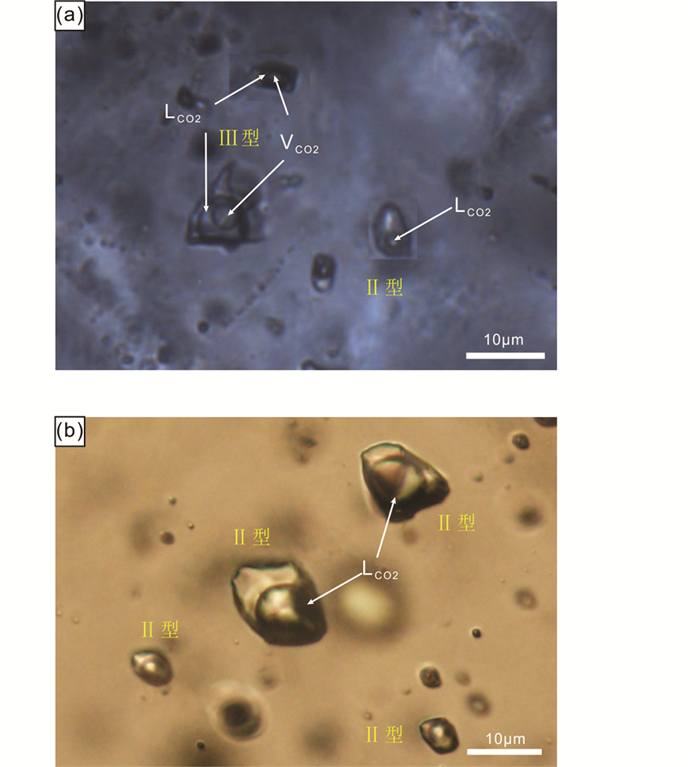
|
图 13 大坪金矿包裹体显微照片 Ⅱ型-含CO2型,Ⅲ型-富CO2型 Fig. 13 Microphotographs of fluid inclusions of the Daping gold deposit Ⅱ type-CO2-bearing type; Ⅲ type-CO2-rich type |
|
|
附表 1 大坪金矿流体不混溶热力学数据 Appendix Table 1 Fluid immiscibility thermodynamic data of Daping gold deposit |
伸展构造系统中造山型金矿主要位于喜马拉雅造山带的北部,典型矿床由西向东分别有沙拉岗锑矿、马扎拉金锑矿和明赛金矿等。金矿床的流体包裹体类型与挤压性造山型金矿极为相似,均以含CO2三相水溶液型和富液相两相水溶液型为主,伴有少量纯CO2型包裹体。成矿流体气相组分以H2O、CO2为主,CO2体积百分比约为0.2~0.8。成矿流体均一温度主要分布于220~320℃,盐度分布范围为2.2%~13.1%NaCleqv; 流体密度集中于0.58~0.88g/cm3,为低密度流体。在伸展构造系统中,矿床的成矿压力为50~240MPa,成矿深度约为1.9~8.9km(莫儒伟等, 2013; Zhang et al., 2020),综合上述特征,伸展构造系统中成矿流体属于中低温-中低盐度-中低压的低密度NaCl-H2O-CO2流体体系。
剪切构造系统中造山型金矿以哀牢山剪切带北部的金厂金矿、镇沅金矿与东南部的长安金矿最为典型。这三个矿床中的流体包裹体特征极为相似,类型均以富液相两相水溶液型为主,含有少量含CO2三相水溶液型与纯液相型包裹体,且具有丰度低、体积小的特征,长径多小于10μm,以孤立状分布为主。气相组分主要为H2O,早期含有少量CO2(5%)、CH4和C2H6; 随着流体的演化和水岩反应的进行,CO2逐渐消失。离子组分以Na+、K+和Cl-、SO42-为主(李士辉等, 2011; Zhao et al., 2013; 熊伊曲, 2014)。主成矿阶段成矿流体均一温度为160~300℃,集中于200~300℃,盐度变化范围较大,主要分布于3%~ 18%NaCleqv,流体密度为0.8~1.2g/cm3(Chen et al., 2010; Zhao et al., 2013)。此外,根据流体包裹体的相变点计算得出长安、镇沅、金厂金矿主成矿阶段的成矿压力分别为24.2~73.9MPa (Chen et al., 2010)、41.0~73.6MPa(邓碧平等, 2014)和60.0~70.2MPa(毕献武和胡瑞忠, 1997),相应的成矿深度分别为0.9~2.7km、1.9~3.3km和2.2~2.6km。综合上述特征,剪切系统内造山型金矿的成矿流体属于低温-低盐度-中低密度的低压流体,为NaCl-H2O流体体系。水岩反应被认为是成矿物质发生沉淀的主要机制(Li et al., 2019)。
对比三种构造系统中的成矿流体特征发现,压扭性构造系统中成矿流体具有最高的压力和最低的盐度,属于高压-低盐度流体,成矿机制主要为温压降低、流体不混溶和流体混合; 成矿深度较深,多形成中深成造山型金矿,CO2含量较高。剪切型构造系统中成矿流体具有低温低压的特征,流体盐度和密度较高,CO2含量极少,矿区内围岩发育广泛的镁铁碳酸盐化表明初始流体中较高的CO2可能被消耗。伸展构造系统成矿流体的温度、压力和密度相对较低,CO2含量略有上升,成矿机制被广泛认为是流体流体温压变化以及与围岩的相互作用。根据矿物组合判断,剪切背景金矿仅在成矿晚期有低温辉锑矿脉侵入,伸展背景金矿锑矿和金矿近乎同期,表明剪切背景成矿主期温度要高于伸展背景,而剪切背景金矿包裹体温度低于伸展背景也表明剪切背景金矿流体经历了演化,使测得的包裹体数据温压数据低于实际成矿流体。此外,测得的包裹体均一温度为最低捕获温度,理论上低于成矿流体的捕获温度,因此不能完全反应成矿流体的真实温压特征。
整体而言,从挤压系统到剪切系统至伸展系统,流体的压力和温度体现了系统性降低,代表了成矿深部的变化。此外,流体压力/温度比值逐步降低,符合不同成矿带形成时期地壳的温压条件的系统变化(图 14)。
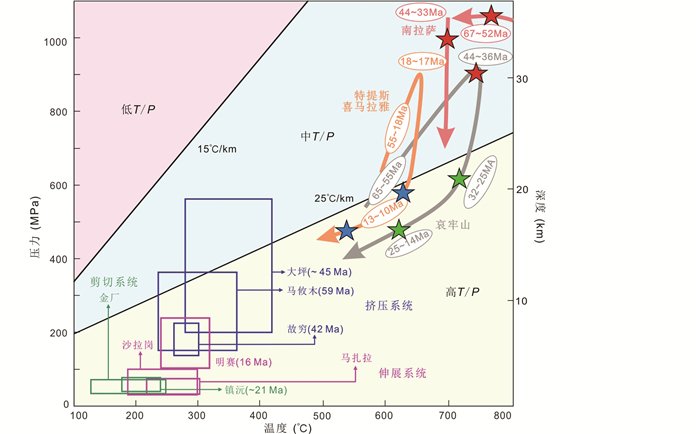
|
图 14 成矿流体温压和区域变质P-T-t轨迹图 星型代表不同变质阶段形成的造山型金矿; 区域变质轨迹据康东艳等(2019), Wang et al. (2018), Liu et al. (2013); 成矿年龄及流体温压据莫儒伟等(2013), 毕献武和胡瑞忠(1997), 邓碧平等(2014), 张刚阳(2012), Zhao et al. (2013), Zhang et al. (2020), Liu et al. (2019), Jiang et al. (2009), Sun et al. (2009) Fig. 14 Fuild P-T condition and regional metamorphic P-T-t curves The star represents formation of orogenic gold deposits in different metamorphic stages. Regional metamorphic curve after Kang et al. (2019), Wang et al. (2018), Liu et al. (2013). Mineralization ages and fluid P-T conditions after Mo et al. (2013), Bi and Hu (1997), Deng et al. (2014), Zhang (2012), Zhao et al. (2013), Zhang et al. (2020), Liu et al. (2019); Jiang et al. (2009), Sun et al. (2009) |
青藏高原新生代三条金成矿带金矿床He-Ar同位素值均高于地壳流体的值(0.01~0.05Ra)(见电子版附表 2、图 15):挤压系统金矿床黄铁矿的3He/4He数值为0.17 ~1.34Ra,中值为1.13Ra(表 2); 剪切系统为0.02~0.86Ra,中值为0.4Ra,落入地幔流体(6~9Ra)和地壳流体范围之间(图 15b); 伸展系统金矿床为0.01~0.09Ra,中值为0.04Ra,大部分落入地壳流体范围(图 15a)。尽管进行He同位素测试的部分黄铁矿不可避免地含有沉积黄铁矿核,但大部分金矿数据落入幔源流体和壳源流体之间仍能表明成矿流体具有部分幔源流体的贡献(Burnard et al., 1999)。
|
|
附表 2 青藏高原主要造山型金矿He-Ar同位素 Appendix Table 2 He-Ar isotope data of the major orogenic gold deposits in Tibet |
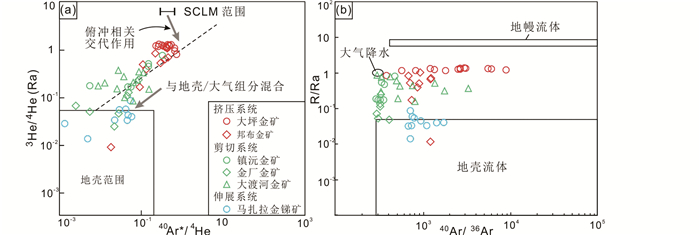
|
图 15 青藏高原新生代造山型金矿床He-Ar同位素图解(据Tan et al., 2018; Wang et al., 2019; Burnard et al., 1999修改) (a)黄铁矿流体包裹体40Ar*/4He-3He/4He(Ra)投图; (b)黄铁矿流体包裹体40Ar/36Ar-R/Ra投图. SCLM-大陆岩石圈地幔.金矿He-Ar同位素数据见附表 2 Fig. 15 He-Ar isotope compositions of Cenozoic orogenic gold deposits in Tibet (modified after Tan et al., 2018; Wang et al., 2019; Burnard et al., 1999) (a) 40Ar*/4He vs. 3He/4He(Ra)plot of fluid inclusions in pyrite; (b) 40Ar/36Ar vs. R/Ra of the fluid inclusions in pyrites. SCLM-Sub-Continental Lithospheric Mantle. Data sources for He-Ar isotope of gold deposits are listed in Appendix Table 2 |
|
|
表 2 青藏高原新生代造山型金矿O、S、He-Ar同位素表 Table 2 O, S and He-Ar isotope data of the Cenozoic orogenic deposits in Tibet |
青藏高原新生代三条金成矿带金矿床流体氧同位素值见电子版附表 3,流体O同位素值根据石英与水的O同位素平衡公式ΔQ-H2O-3.38×106/T2-3.4(Clayton et al., 1972)计算获得。挤压系统金矿床δ18OH2O值为6.0‰~13.1‰,中值为7.2‰(表 2); 剪切系统δ18OH2O值为6.2‰~12.3‰,中值为9.3‰; 伸展系统金矿床δ18OH2O值为6.4‰~16.2‰,中值为10.7‰。金矿床δ18OH2O值总体偏向正值,且不同构造系统之间金矿床δ18OH2O值具有增高的趋势(图 16a)。这种差异的一个很重要的原因是计算流体δ18O的温度被低估,另外水岩反应也可以一定程度改变热液矿物的δ18O。造山型金矿的氢同位素一直很难被解释; 马攸木金矿和邦布金矿两个矿床的δ18O值均落在很窄的范围内(4‰~10‰),但它们的δD值变化范围大。
|
|
附表 3 青藏高原主要造山型金矿流体氧同位素表 Appendix Table 3 Oxygen isotope data of the major gold deposits in Tibet |
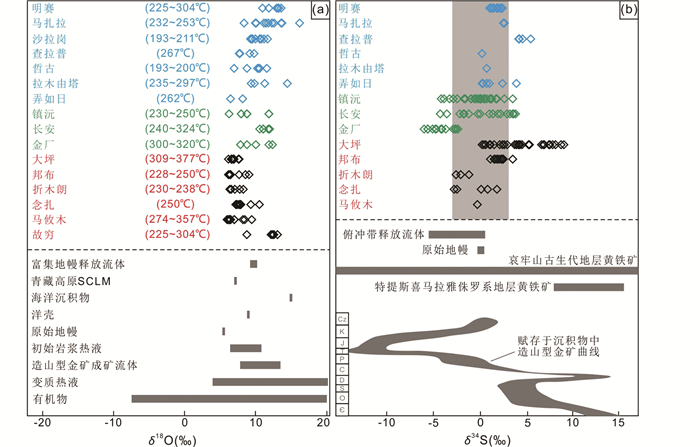
|
图 16 青藏高原新生代三大构造系统中造山型金矿床同位素图解 (a)三大构造系统中金矿床δ18O值与富集地幔释放流体、原始地幔(Korolev et al., 2018)、青藏高原SCLM(Wang et al., 2015)、洋壳(Korolev et al., 2018)、海洋沉积物(Alt and Shanks, 2006)、大部分造山型(Goldfarb et al., 2004)、岩浆热液、变质热液和有机物(Sheppard,1986)氧同位素对比; (b)三大构造系统中金矿床δ34S值与原始地幔(Labidi et al., 2015)、哀牢山古生代地层黄铁矿(Wang et al., 2019)、俯冲带释放流体(Li et al., 2020)、特提斯喜马拉雅侏罗系地层黄铁矿(Zhang et al., 2020)、不同时代沉积岩容矿造山型金矿据(Chang et al., 2008)对比.金矿床δ18O和δ34S数据见附表 3和附表 4 Fig. 16 Isotope diagrams of Cenozoic orogenic gold deposits in three tectonic systems of Tibet (a) plot of δ18O ratios of gold deposits in three tectonic systems, comparable data includes mantle released fluids, primary mantle (Korolev et al., 2018), Tibetan SCLM (Wang et al., 2015), oceanic crust (Korolev et al., 2018), marine sediments (Alt and Shanks, 2006), most orogenic deposits (Goldfarb et al., 2004), and magmatic, metamorphic, and organic water (after Sheppard, 1986); (b) plot of δ34S ratios of gold deposits in three tectonic systems, with comparison to that of primary mantle (Labidi et al., 2015), subduction zoon released fluids (Li et al., 2020), pyrite in Ailaoshan Paleozoic formation (Wang et al., 2019), pyrite in Tethyan Himalaya Jurassic formation (Zhang et al., 2020) and temporal curve of sedimentary-host orogenic gold deposits (after Chang et al., 2008). Data sources for δ18O and δ34S values of gold deposits and porphyry deposits in Tibet are listed in Appendix Table 3 and Appendix 4, respectively |
青藏高原新生代三条金成矿带矿床黄铁矿硫同位素值见电子版附表 4。金矿床矿石黄铁矿δ34S值多数分布在0值附近(图 16b),绝大多数与大陆岩石圈和俯冲带释放流体的δ34S值重合(Lee et al., 2018; Li et al., 2020)。挤压系统中金矿床矿石黄铁矿δ34S值变化范围较大,为-2.8‰~9.1‰,中值为2.5‰,其中哀牢山大坪金矿床黄铁矿δ34S值偏向正值,较为异常,与扬子板块西缘中生代造山型金矿相似(Wang et al., 2020a)。剪切系统δ34S值为-6‰~3.9‰,中值为-0.4‰,其中金厂矿床矿石黄铁矿δ34S值均为负值,导致整体δ34S值变化范围较大且略微偏向负值。伸展系统中金矿床矿石黄铁矿δ34S值变化范围较小集中在0左右,为0.3‰~5.5‰,中值为1.9‰。
|
|
附表 4 青藏高原主要造山型金矿黄铁矿硫同位素 Appendix Table 4 Suifur isotope data of pyrite of the major orogenic gold deposits in Tibet |
造山型金矿中成矿流体的就位和矿质沉淀受构造和水岩反应共同控制(Hodkiewicz et al., 2009; Williams-Jones et al., 2009; Groves et al., 2018; Yang et al., 2018)。研究发现岩石圈尺度构造通常为成矿流体的运移通道(Vearncombe, 1998; Tripp and Vearncombe, 2004),而成矿带-矿田尺度剪切带或断裂控制造山型金矿的产出(Groves et al., 2018)。这些矿床尺度控矿构造包括褶皱转折端和层间滑脱带通常是矿体赋存的有利部位(Cox et al., 1991)、断裂弯曲转折端(Yang et al., 2018)、剪切带张性或压性衔接部位(Hodkiewicz et al., 2009)、里德尔剪切派生裂隙以及不同断裂相交点和、侵入体与其他岩性接触部位(Groves et al., 2018)。流体进入成矿有利部位与赋矿围岩发生水岩反应,通过矿物溶解沉淀诱发岩石软化,导致岩石更易发生破裂(Bierlein and Maher, 2001; Sausse et al., 2001; Yasuhara et al., 2006)。此外,水岩反应可通过硫化、改变成矿物理化学条件等导致金沉淀(Seward and Barnes, 1997; Hodkiewicz et al., 2009; Williams-Jones et al., 2009)。
氧化作用是流体卸载金的有效机制(Robert, 1987),通过δ34S值可以判断流体是否发生过氧化作用。在金沉淀过程中,出现硫酸盐物质会导致硫化物δ34S值偏负。Evans et al.(2006)使用模拟计算来解释Golden mile矿床热液黄铁矿δ34S值(-10‰~-2‰)与邻近Golden Mile辉绿岩的Paringa玄武岩中黄铁矿δ34S值(0‰~4‰)相比偏向负值的现象。一些位于Yilgarn克拉通的金矿床,如Victory-Defiance和New Celebration等具有类似的现象(Hodkiewicz et al., 2009)。Porgera金矿床中,单个黄铁矿晶体富金区域δ34S值偏负(-16.24‰~-9.21‰),而贫金区域δ34S值偏正(-2.04‰~7.3‰),这种现象表明流体在低压条件下快速蒸发导致流体发生氧化(Weatherley and Henley, 2013)。导致热液流体发生氧化的方法有许多种,沸腾可以导致含矿流体中的还原性气体通过相分离而聚集,从而能够有效地使含矿流体氧化; 由于造山型金矿在金沉淀发生水岩反应的过程中水岩比较低(Phillips and Powell, 2010),因此含矿流体与矿区中的氧化性围岩发生均一化反应也会导致流体氧化。哀牢山带金厂金矿S同位素值偏负,这是由于金厂金矿的成矿围岩为氧化的超基性岩,含大量的磁铁矿。邦布和大坪矿床S同位素值偏正可能是流体上升过程中,地壳物质混染所造成的。而其他金矿黄铁矿δ34S值均集中在0附近(图 16b),表明大多数矿床赋矿围岩为还原性岩石,对硫同位素影响较小。这种情况下,流体中的硫化物S同位素值可以代表热液流体的S同位素值(Ohmoto, 1972, 1986)。
对于喜马拉雅造山带Au-Sb矿床而言,我们认为两者为同一流体不同阶段沉淀的产物。William-Jones and Norman (1997)证明了温度高于350℃时,热液中含有10×10-6的Sb才会发生沉淀,而当温度低于250℃时,只要1×10-6便可沉淀成辉锑矿。由于造山型金矿广泛形成于抬升的背景,流体温度演化到晚期低温条件下,锑矿化呈石英脉的形式灌入到早期形成的金矿中,这种现象在世界上许多造山型金矿均可出现,如Vitoria矿集区的Bendigo金矿(Wilson et al., 2013),Otago Schist矿集区的Bullendale金矿(MacKenzie et al., 2007)和Reefton Goldfield矿集区的Globe-Progress金矿(MacKenzie et al., 2016)。
5.2 物质来源变质流体和地幔来源是目前广泛接受的且相互对立的流体来源,它们分别对应“变质流体成因模式”(Phillips and Powell, 2009, 2010, 2015; Tomkins and Grundy, 2009; Tomkins, 2010)和“幔源成因模式”(Deng et al., 2015b; Kolb et al., 2015; Zhao et al., 2019; Wang et al., 2019; Groves et al., 2020)。“变质流体成因模式”认为在绿片岩相到角闪岩相的进变质过程中,绿片岩相岩石(特别是变基性岩)脱水作用是造山型金矿的流体来源(Phillips and Powell, 2009; Tomkins, 2010);“幔源成因模式”可分为俯冲洋壳脱水与流体回返模式(Peacock, 1990; Sibson, 2004; Peacock et al., 2011)、克拉通破坏富集地幔脱气模式(Goldfarb and Santosh, 2014; Deng et al., 2015a)和岩石圈拆沉富集地幔脱气模式(Zhao et al., 2019; Wang et al., 2019)。如前所述,造山型金矿的物质来源存在很大的争议,我们可以从造动力学背景、矿床地球化学和矿床地质特征等几个方面来综合限制物质来源。
在构造动力学背景角度,挤压系统造山型金矿形成于三个不同的时期(约60Ma、50Ma和44Ma),和多期印度-欧亚的碰撞速率降低相对应; 而大渡河-锦屏山成矿带也存在着32Ma到20Ma的多期成矿事件。对于变质脱水模型,源区不可能多次变质释放流体。而构造-成矿事件具有突发性,和缓慢的变质过程不相符合。对于哀牢山浸染型金矿床以及喜马拉雅成矿带,其形成于区域退变质阶段(图 14),而退变质阶段一般是吸水过程而不是释放水过程(Tomkins, 2010; Zhong et al., 2015)。金成矿作用与洋壳断离、大陆岩石圈板片回撤和块体旋转后应力松弛等不同地球动力学背景下引发的地幔扰动事件同期发生,这些证据都支持成矿物质可能与地壳内构造运动和物质活化没有直接成因关系。雅鲁藏布江缝合带出露的林子宗火山岩(Lee et al., 2009)和哀牢山带出露的煌斑岩(Guo et al., 2005)也证明了成矿期存在地幔扰动事件。所有造山型金矿床均沿板块缝合带分布,也支持成矿物质可能来源于地幔层次的观点。同时He-Ar同位素显示金矿具有显著的幔源特征(图 15)。
对于相似的构造部位,不同构造区域、成矿时间及形成深度的矿床,比如雅鲁藏布江带中成邦布以及哀牢山带的中-浅成镇沅和长安等,整体都具有类似的S-O同位素特征,显示了类似的物质来源,而该来源不受区域地壳组成不同的控制,成矿流体应该来自于地壳之下的层圈。另外,含金黄铁矿与围岩中沉积黄铁矿S同位素值不一致; 如在剪切系统中,载金黄铁矿的富金边部δ34S值(-3‰~3‰)以及黄铁矿δ34S值集中分布区域的中值(0‰~3‰; 胡云中等, 1995; Chen et al., 2010; 李士辉等, 2013; Deng et al., 2015c; 熊伊曲等, 2015),这与泥盆纪到石炭纪的变质沉积围岩不一致; 传统认为造山型金矿δ34S值是围绕着造山型金矿沉积围岩δ34S值曲线(平行于海洋硫酸盐δ34S值曲线)分布的(Chang et al., 2008); 而青藏高原金矿的δ34S值偏离了造山型金矿的沉积围岩δ34S值曲线; 此外,沉积黄铁矿拥有很低的金(低于10×10-6,平均1.5×10-6)和砷(2.3×10-6~10, 400×10-6)(Zhang et al., 2014b; 未发表的数据),这显然与载金黄铁矿热液边缘金含量高达100n×10-6是有明显区别的。相同成矿带中不同矿床的δ18OH2O值范围相同(图 16a),指示金矿具有相同的流体来源,而且不太可能是源于变质地壳。
尽管各矿床S-O同位素值也符合岩浆流体的同位素特征(~0‰; Hoefs, 2009),然而岩浆流体形成的金矿(斑岩型或表生热液型)常常氧逸度较高,较造山型金矿,热液中S的含量更高(Hedenquist and Lowenstern, 1994; Simon and Ripley, 2011; Pokrovski et al., 2015); 而青藏高原三种构造背景形成的造山型金矿,发育的蚀变矿物均呈还原型,较高氧逸度的岩浆热液形成的矿物如硫酸盐,磁铁矿和褐铁矿均未发现,因此我们推测成矿流体不为岩浆流体。对于喜马拉雅成矿带,其物质来源存在多种观点,比如大气降水、岩浆热液以及两者的混合。需要注意到的其蚀变矿化组合与典型的大气降水循环形成的浅成低温热液矿床(如腾冲的梁河金矿)存在明显的区别,后者以弥散状泥化、明矾石化等为特征,而西藏伸展背景的金矿发育典型的低温造山型金矿的绢云母和碳酸盐蚀变矿物组合。
综合的S-O-D同位素特征均可以用地幔流体来源来合理解释。δ34S较低的硫化物如黄铁矿和磁黄铁矿可能随板片俯冲循环到深部地幔,随着温度和压力升高,板片脱水,黄铁矿分解形成磁黄铁矿,释放还原性流体; 俯冲带释放流体的δ34S在0‰左右(-2.5‰±3‰; Li et al., 2020),从而富集地幔中的δ34S也在0‰左右(-2.5‰±3‰,Lee et al., 2018; Li et al., 2020),这种俯冲带流体以及富集地幔的δ34S特征和大部分缝合带附近造山型金矿的S同位素一致; 俯冲过程中δ34S较高的硫酸根离子在俯冲带浅部已释放,未能循环到深部地幔,大坪金矿的高δ34S可能与这种硫酸根流体交代形成的早期富集地幔有关(Wang et al., 2020a)。俯冲板片释放含S流体回返地壳形成造山型金矿,这对于理解深部S循环研究有重要意义。拉萨地块富集地幔氧同位素δ18O=7.1‰(Wang et al., 2015),根据Zheng(1993)氧同位素分馏公式(1031nα=A×106/T2+B×103/T+C; 其中T为开尔文温度=摄氏温度+273.15℃; 橄榄石-水和辉石-水的分馏系数为A=3.55,B=-9.72,C=2.64),计算出在800~1200℃地幔释放流体δ18O=9.3‰~10.2‰(图 16a),另外板块释放流体的δ18O也为8‰~10‰(Alt et al., 2012),富集地幔和俯冲带释放流体的δ18O和缝合带附近造山型金矿的δ18OH2O整体上是类似的。需要指出的是,大部分文献中造山型金矿的δ18OH2O计算都是偏低的一点。马攸木矿床和邦布矿床δ18O值相似(δ18O≈4‰~10‰),马攸木矿床氢同位素值更低(图 17),这可能是由于马攸木矿床形成时大洋俯冲板片角度较缓,温度较高的俯冲板片在交代岩石圈地幔浅部脱水形成成矿流体,为亚临界流体,δD值较低。50Ma左右,随着碰撞作用持续进行,大洋板片回撤,俯冲角度更陡,温度较低的俯冲板块和沉积物达到150±30km脱水形成超临界流体(δD≈-40‰~-80‰; Walowski et al., 2015; Dixon et al., 2017),可以形成更高的δD值(Walowski et al., 2015); 在俯冲深度在100~130km的时候,硫的释放通量也基本处于高峰期(Li et al., 2020)。地幔流体的释放可以包括两种形式:(1)俯冲过程中直接回返到浅部地壳形成造山型金矿,比如雅鲁藏布江成矿带可能与俯冲板片释放流体的直接回返有关(Dixon et al., 2017); (2)以自由流体或者含水矿物的形式被捕获在交代地幔中,哀牢山造山型金矿形成于新生代,其成矿流体可能与元古代和古生代大洋俯冲而形成的富集地幔有关(Wang et al., 2020a)。
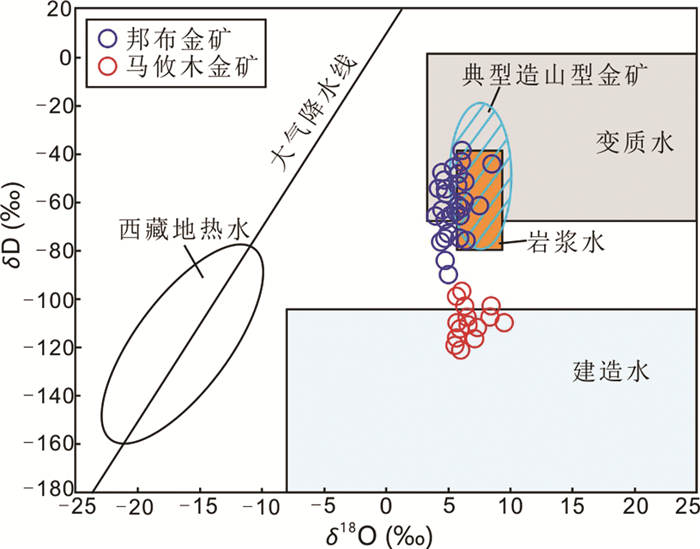
|
图 17 邦布金矿和马攸木金矿氢氧同位素图解(据Han et al., 2020修改) 岩浆水、变质水和建造水范围据Sheppar (1986);造山型金矿范围据Goldfarb et al. (2004);西藏地热水据郑淑蕙等(1982);邦布金矿数据据Pei et al. (2016)和孙晓明等(2010); 马攸木金矿数据据Jiang et al. (2009) Fig. 17 Hydrogen-oxygen isotope plot of the Bangbu and Mayum gold deposits (modified after Han et al., 2020) Field of values for magmatic, metamorphic and formation water after Sheppard (1986); field of values for typical orogenic gold deposits after Goldfarb et al. (2004); values for meteoric water in Lhasa after Zheng et al. (1982); data for the Bangbu gold deposit after Pei et al. (2016), Sun et al. (2010); data for the Mayum gold deposit after Jiang et al. (2009) |
喜马拉雅金矿带具有较高的δ18OH2O值以及较低的3He/4He数值,表明物质来源中有大量的大陆物质的贡献。而区域演化和矿床蚀变显示成矿流体来源自变质和岩浆流体的可能性较小,而此时印度大陆地壳回撤,引发岩石圈地幔扰动和大量斑岩矿床的形成,从而被大陆地壳物质改造的岩石圈地幔脱气形成成矿流体成为一个合理的解释; 最近明赛金矿的发现,证实存在较深层次来源的金矿系统,而其S同位素组成明显和浅部的金-锑成矿系统一致,代表存在一个深层次的统一的流体来源。还有一个可能是来自于俯冲的印度大陆地壳,其回撤过程中地幔上涌引发俯冲中的地壳物质发生变质作用而释放流体。
6 输运介质和流体通道 6.1 幔源流体和输运介质铂族元素(PGE)通常用于研究源于地幔的岩石和岩浆硫化物矿床(Barnes et al., 2015; Aulbach et al., 2016; Deng et al., 2017; Wang et al., 2018; Park et al., 2019),而很少用于研究造山型金矿成矿物质来源(Sun et al., 2009)。交代地幔楔硫化物的PGE含量配分型式的研究表明(Alard et al., 2011; Rielli et al., 2018)PGE在部分熔融过程和热液流体产生过程中具有不同的化学行为(Boudreau and McCallum, 1992; Mungall and Brenan, 2014; Barnes et al., 2015; Richards, 2015b)。大坪和金厂金矿硫化物PGE组成见图 18(详细数据见电子版附表 5),与初始地幔相比(Palme and O'Neill, 2014),金厂略微富集Ru,大坪个别样品富集Rh,其他样品均表现出PGE亏损特征,其中又以Pt亏损最为显著(图 18a)。PGE配分型式和丹巴金矿、法国南部(Alard et al., 2011)和挪威(Rielli et al., 2018)交代地幔楔中的硫化物PGE配分型式十分相似,都具有显著亏损Pt,略微富集Ru和Pd的特征(图 18a)。哀牢山新生代大坪和金厂金矿与扬子西缘中生代丹巴金矿类似,均具有亏损Pt而中等富集Ru的特征,这与区域煌斑岩(Guo et al., 2005; Gan and Huang, 2017)和全球斑岩Cu-Au矿床(Augé et al., 2005; Cocker et al., 2015; Gao et al., 2015; Park et al., 2019)呈正倾斜的PGE配分型式完全不同。
|
|
附表 5 大坪、金厂、丹巴金矿PGE组成(×10-9) Appendix Table 5 PGE compositions (×10-9) of the Daping, Jinchang and Danba gold deposit |

|
图 18 大坪、金厂和丹巴金矿PGE图解 (a)大坪、金厂和丹巴金矿与哀牢山煌斑岩(据Gan and Huang, 2017)、交代地幔楔硫化物(据Alard et al., 2011; Rielli et al., 2018)和斑岩型矿床(据Augé et al., 2005; Cocker et al., 2015; Gao et al., 2015; Park et al., 2019)地幔标准化PGE配分型式图; (b)大坪、金厂和丹巴金矿与其他端元Pd/Ir-Ru/Ir投图及氧化态对比(据Rielli et al., 2018); (c)Pd/Pt-Ru/Pt投图比较不同端元之间Pt富集/亏损的区别.大坪、金厂和丹巴金矿PGE数据来源见附表 5 Fig. 18 PGE characteristics of Daping, Jinchang and Danba deposits (a) primitive mantle-normalized PGE patterns for the Daping, Jinchang and Danba deposits (lamprophyres on the Ailaoshan from Gan and Huang, 2017; sulfides in metasomatzied mantle lithosphere wedge from Alard et al., 2011 and Rielli et al., 2018; ore samples of porphyry deposits from Augé et al., 2005; and felsic intrusions associated with porphyry mineralization from Cocker et al., 2015; Gao et al., 2015; and Park et al., 2019). (b) Pd/Ir vs. Ru/Ir plot showing comparison of oxidation state between the Daping, Jinchang and Danba deposits and other endmembers (based on Rielli et al., 2018). (c) Pd/Pt vs. Ru/Pt plot displaying systematic difference of Pt enrichment/depletion among different endmembers. Data sources for the PGE compositions data of the Daping, Jinchang and Danba deposits are listed in Appendix Table 5 |
部分熔融过程中Ir组元素(Ru、Ir)保留在残余地幔的铬铁矿和橄榄石中(Mungall and Brenan, 2014)或形成硫钌矿(Bockrath et al., 2004),而Pt组元素(Pt、Pd)则富集在硅酸盐熔体中(Barnes et al., 2015; Aulbach et al., 2016; Lorand and Luguet, 2016)因此,部分熔融产物中的Pd/Ir值会增高,而Ru/Ir值则相对不变。而且,Pd在流体中的溶解度比Pt更高(Barnes and Liu, 2012),Ru在流体中的活动性比Ir更强(Keays et al., 1982; Wood, 1987; Lorand et al., 2008)。因此,铂族元素分馏会导致热液系统中Pd/Ir、Ru/Ir、Ru/Pt以及Pd/Pt比值升高(图 18b, c; Barnes et al., 2015)。法国南部(Alard et al., 2011)和挪威(Rielli et al., 2018)交代岩石圈地幔中硫化物高Pd/Ir、Ru/Ir、Ru/Pt、和Pd/Pt比值被认为是由于板片释放的含水流体交代岩石圈地幔导致的。青藏高原代表性造山型金矿也具有高Pd/Ir、Ru/Ir、Ru/Pt和Pd/Pt比值和PGE配分型式(图 18),表明硫化物同样源于交代地幔,由热液流体形式而非岩浆过程被输运到地壳。
6.2 岩石圈结构与成矿流体通道软流圈上涌被认为是形成大型造山型金矿的重要因素(Hodgson, 1993; Kerrich et al. 2000b; Bierlein et al., 2001, 2004; Goldfarb et al., 2001)。较厚的次大陆岩石圈地幔(SCLM)会隔绝软流圈热物质上涌从而阻碍大规模流体释放形成大型造山型金矿(Bierlein et al., 2006)。本文提供了另外一个可能的解释,即由于大洋的俯冲和挤压作用,成熟岛弧区的岩石圈地幔会发生加厚; 在加厚的岩石圈地幔中有利于储存富集地幔产生的岩浆而发生再次富集(Chin et al., 2014); 此外,较厚的岩石圈地幔有利于形成超临界流体(图 19a),造山带深部可发生地幔扰动和软流圈物质上涌,由加厚的富集地幔生成的成矿流体在源区受到的压力大于流体会聚区,成矿流体在加厚岩石圈的压力下沿岩石圈断裂上升流向岩石圈厚度薄的部位,从而在岩石圈厚度突变处形成造山型金矿(图 19b)。压力是确定流体流动方向和空间聚集的主要驱动力,对地幔源区施加较大的压力,流体便会被泵入连接较薄岩石圈的裂隙中。比如,始新世至中新世期间,雅鲁藏布江缝合带北侧拉萨地块地壳经地壳增长和复式褶皱作用增厚,而南侧喜马拉雅造山带地壳厚度基本不变(Wang et al., 2014a),造山型金矿多产于雅鲁藏布江缝合带南侧(图 2b); 在哀牢山构造带,矿床位于岩石圈厚度较薄的次级变质带。
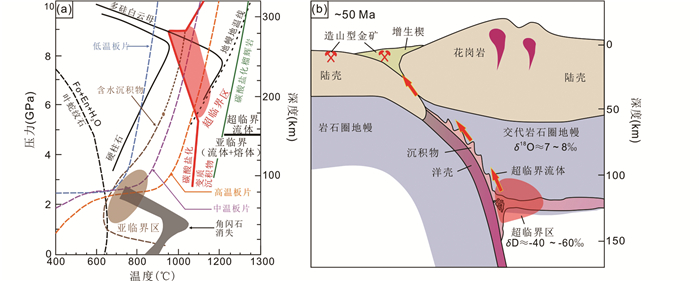
|
图 19 俯冲区板片及矿物P-T图解和造山型金矿成矿流体地幔成因模式 (a)俯冲板片及矿物P-T图解(据Dixon et al., 2017修改),展示不同性质俯冲板片温度和压力变化情况,亚临界区(俯冲深度 < 120km)含水沉积物脱水和熔融形成亚临界流体和岛弧型岩浆,超临界区(深度>120km)以碳酸盐脱水和熔融形成超临界流体和富集地幔端元物质; (b)造山型金矿流体运移模式图,交代岩石圈地幔底部形成的超临界流体沿板片边界向浅部运移,过程中可能有由俯冲板片释放并与岩石圈反应后形成的流体加入,最终在地壳浅部形成造山型金矿 Fig. 19 P-T diagram of subduction slab and minerals in subduction zoom and schematic model for the mantle derivation of orogenic gold fluid (a) P-T diagram showing a plausible range of divers subduction slab and minerals P-T paths (modified after Dixon et al., 2017), water-dominated dehydration and melting processes generate the sources of arc magmas in subcritical zoom (depth < 120km), while carbonate-dominated melting processes generate the sources for enriched mantle end-members in supercritical zoom (depth >120km); (b) schematic illustrations of ore-forming fluid migration process of orogenic gold deposits. Supercritical fluids generated in the base of metasomatized lithosphere mantle migrate upward along the boundary between different slabs, meanwhile the fluid formed after the release of subducted slab and the reaction with the lithosphere mantle may be added, eventually forming the orogenic gold deposit in the shallow level of the crust |
流体通道连接着成矿流体的源区和会聚区。根据地质和地球物理剖面,可以清晰地圈定喜马拉雅造山带和拉萨地块的导矿通道系统(图 20a, b)。在中-下地壳层次,两个板块之前的接触界面是主要的导矿通道; 中地壳层次,雅鲁藏布江缝合带北部冈底斯岩基和南部的复式褶皱系统显示有很强的不连续性,是良好的导矿通道; 在上地壳层次,蛇绿岩缝合带充当流体的隔水层,流体在蛇绿岩缝合带下方迁移,进而输运到紧闭褶皱系中,因为紧闭褶皱中更易发生高角度断裂; 在伸展体系中,流体则运移进入地壳浅部穹窿边界就位。
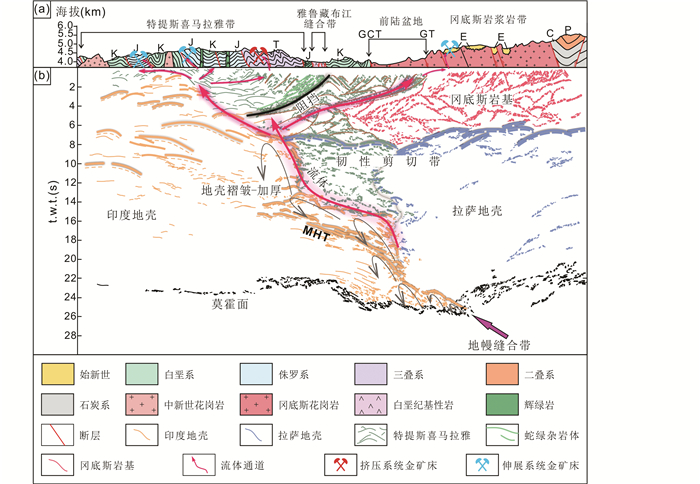
|
图 20 青藏高原正向碰撞区造山型金矿带深部结构解译和成矿流体输运趋势推断(据Guo et al., 2018修改) t.w.t.-双程走时. GCT-大反转逆冲断层; GT-冈底斯逆冲断层; MHT-主喜马拉雅逆冲断层 Fig. 20 Interpretation of deep structure of orogenic gold belts in the Tibet normal collisional zone and the deduction of migration of orogenic gold fluid (seismic reflection profile was modified after Guo et al., 2018) t.w.t.-two-way time. GCT-Great Counter Thrust; GT-Gangdese Thrust; MHT-Main Himalayan Thrust |
在哀牢山地区,哀牢山剪切带的左旋运动和北西向的剪切带和断裂控制着金矿的位置和流体的运移。区域尺度上,金平地块位于哀牢山剪切带张扭转换处,此处哀牢山剪切带的走向更偏北西。长安金矿中,以左旋走滑为特征的北东倾的长安断裂控制了背斜一翼的豆荚状矿体。在蛇绿岩带,区域尺度上,一系列的造山型金矿位于次级剪切带上,和哀牢山剪切带走向一致,矿体多狭窄; 矿床尺度上,最大的镇沅和金厂矿床位于次级剪切带交汇处,断裂密度大并且地壳渗透性高。在剪切系统中,沿北西向哀牢山剪切带运移的深部流体被封闭在渗透率差的岩石中,通过剪切带下渗透性好的变质沉积岩中运移到上地壳。成矿流体延哀牢山断裂运移到紧闭褶皱中的断裂弯曲处,与不同种类的岩石反应,在1~3km地壳深度处形成多种矿化类型的浅成浸染状金矿(Wang et al., 2019)。
7 成因模式和找矿潜力 7.1 成矿构造动力学青藏高原新生代大陆碰撞带具有三个主要演化阶段。
(1) 约45~40Ma之前,多种类型的岩浆活动表明新特提斯洋板块发生俯冲和断裂导致岩石圈缩短(图 21a, b)。此次构造事件导致哀牢山剪切带经历了高温变质作用。深部地幔扰动导致含金成矿流体向浅表运移,沿着雅鲁藏布江缝合带形成了一系列的造山型金矿,新元古代大陆岛弧基底之上的哀牢山金平地体则形成了大坪金矿床(图 21a)。早-中新世至中-中新世期间,喜马拉雅带北部海拔快速升高(Ding et al., 2017),深俯冲的部分印度板片通过向南仰冲叠置重返地壳浅部(Gao et al., 2016),在雅鲁藏布江缝合带西部表现为北倾的雅鲁藏布江蛇绿岩弯曲为南倾,随着大陆碰撞持续进行,南倾的雅鲁藏布江蛇绿岩被褶皱并剥露地表形成Yungbwa蛇绿岩(Guo et al., 2018)。马攸木矿床位于雅鲁藏布江蛇绿岩带和Yungbwa蛇绿岩之间,代表其为蛇绿岩带褶皱之前形成。

|
图 21 青藏高原新生代造山型金矿构造动力学模型(据Yin, 2010; Guo et al., 2018; Deng et al., 2014b; Wang et al., 2019修改) (a、b)早始新世; (c、d)渐新世至早中新世; (e、f)中中新世至今. GLS-甘孜-理塘缝合带; JS-金沙江缝合带; ASS-哀牢山缝合带; LSS-龙木措-双湖缝合带; CMS-昌宁-孟连缝合带; BNSZ-班公湖-怒江缝合带; YTSZ-雅鲁藏布江缝合带; SBS-掸邦缝合带; ARSZ-哀牢山-红河剪切带; ATF-阿尔金断裂; CSZ-重山剪切带; GLGF-高黎贡; JLF-嘉黎断裂; SGF-实皆断裂; Tv-林子宗火山岩 Fig. 21 Geodynamic evolution of the Tibet Cenozoic orogenic gold belts (modified after Yin, 2010; Guo et al., 2018; Deng et al., 2014b; Wang et al., 2019) (a, b) Early Eocene (55~5Ma); (c, d) Oligocene to Early Miocene (30~25Ma); (e, f) Middle Miocene to Present (25~0Ma). GLS-Garzê-Litang Suture; JS-Jinshajiang Suture; ASS-Ailaoshan Suture; LSS-Longmu Tso Shuanghu Suture; CMS-Changning-Menglian Suture; BNSZ-Bangong-Nujiang Suture Zone; YTSZ- Yalung Tsangpo Suture Zone; SBS-Shan Boundary Suture; ARSZ-Ailaoshan-Red River Shear Zone; ATF-Altyn tagh Fault; CSZ-Chongshan Shear Zone; GLGF-Gaoligong Fault; JLF-Jiali Fault; SGF-Saging Fault; Tv-Linzizong volcanics |
(2) 随着印度岩石圈持续缩进,青藏高原东缘斜向大陆碰撞带中的块体被挤压变形,沿着哀牢山剪切带发生大规模位移,块体走向由NW向转变为NNW向(图 21c)。剪切作用后,金平地体从华南地块西北端剪切到西南端,移动距离约500~700km,在古特提斯缝合带和金平地体中形成了系列造山型金矿床(图 21d)。造山金成矿与淡色花岗岩侵位和哀牢山地区地壳剥蚀同期发生,表明在此时期地壳地温梯度有所升高,这种现象通常与地幔扰动有关。此阶段地幔扰动可能源于块体旋转后发生的应力松弛。
(3) 与喜马拉雅金矿带造山型金矿同期(图 21e),南拉萨地块东部与埃达克质花岗岩有关的斑岩Au-Cu矿床和地壳穹窿中的淡色花岗岩(图 4a)均形成于印度大陆岩石圈板片回撤背景,暗示这一期的造山型金矿化可能与印度大陆回撤造成的地幔扰动有关(图 21f)。
7.2 成因模式根据青藏高原造山型金矿时空分布、构造背景和物质来源的分析,对造山型金矿成因有重要指示意义。可以尝试总结一下由此获得的造山型金矿成因的新认识:(1)成矿物质可以起源于早期大洋俯冲的富集地幔,不一定是同期俯冲造成的地壳变质流体或者俯冲大洋板块或者沉积物的脱水,随后的大陆俯冲也可能进一步改造富集岩石圈地幔; (2)大陆碰撞阶段形成的的紧密褶皱系成为造山型金矿赋存的重要构造单元,早期构造活动为后期流体输运就位提供了构造格架; 成矿期的构造事件主要是形成或者再活化沟通深-浅部的构造通道,其叠加于早期的构造格架之上; (3)喜马拉雅带和哀牢山带金矿成均发生于板块会聚速率骤降的时期(图 5)。大洋或者大陆板块的回撤或断离等构造突变事件,改变岩石圈热结构和应力状态,浅部地壳从压性向压剪构造乃至张性构造转换,流体从加厚岩石圈的富集地幔释放,汇聚于较薄岩石圈的断裂密集部位或者不同构造单元分界。
7.3 找矿潜力我们从古、新特提斯构造域造山型金矿成矿空间分布对比的角度对区域成矿潜力做了简单评估。古特提斯的造山型金矿主要分布在秦祁昆造山带、扬子西缘穹隆带以及华南板内右江盆地等三个区域(图 22a),形成时代主要是三叠纪至侏罗纪早期,形成于大洋板块回撤、断离以及碰撞后的伸展环境,其矿床类型以深成和中成为主,有少量浅成矿床。而相对于古特提斯的造山型金矿,新特提斯闭合后的碰撞造山环境造山型金矿分布在早期和同期的板块缝合带以及大陆碰撞造山带(喜马拉雅造山带); 古、新特提斯构造域造山型金矿具有较大的相似性,比如板块缝合带是重要成矿环境,碰撞后的穹隆环境发育了重要的造山型金矿带。两者对比对新特提斯的找矿提供了重要启示,而对于俯冲带弧后地区(拉萨地块)也是造山型金矿产出的重要部位,现在发现造山型金矿较少,是之后造山型金矿勘探的重要地区; 从成矿类型看,碰撞造山带主要发育中成和浅成金矿(图 22b),深成造山型金矿的缺失代表区域剥蚀程度较浅,深部仍有较大的找矿潜力。
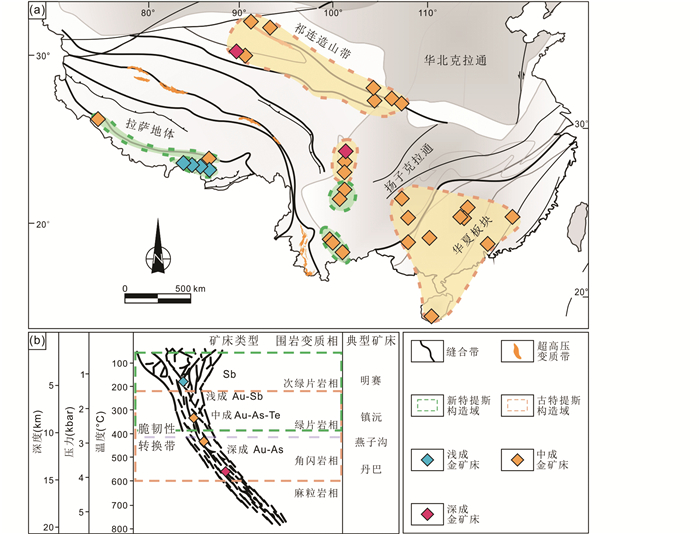
|
图 22 特提斯域造山型金矿分布图(a,据Deng and Wang, 2016修改)、特提斯域造山型金矿地壳连续成矿模型(b,据Groves, 1993; Groves et al., 1998修改) Fig. 22 Spatial distribution (a, after Deng and Wang, 2016) and crustal continue model (b, modified after Groves, 1993; Groves et al., 1998) of Tethyan orogenic gold deposit |
(1) 青藏高原大陆碰撞造山环境形成了雅鲁藏布江缝合带挤压环境金矿带、哀牢山造山带剪切环境金矿带和喜马拉雅造山带伸展环境金矿带三条主要矿带。这三条金矿带中矿床地质和成矿流体特征显示,金矿化存在由中成石英脉型到中-浅成浸染型、浅成细脉-浸染型的系列演化。
(2) 造山型金矿受岩石圈构造事件控制,多与板块会聚速率骤降同步,主体与大洋或大陆板块的回撤或断离等突变事件引发地幔扰动有关。金矿化一般发生在青藏高原地壳厚度增长的前缘,处于较厚的岩石圈地幔邻侧岩石圈厚度减薄的环境中。区域上,金矿床受主干断裂和紧闭褶皱系控制,高密度断裂带以及穹窿边缘控制着浅部矿体就位。
(3) 虽然受到成矿时的水岩反应等过程的影响,不同构造区带和围岩类型的矿床S、O同位素具有类似的特征,He-Ar同位素则显示金矿化具有明显的幔源特征,矿石硫化物具有和岩浆热液有关矿床完全不一样的PGE特征。区域构造成矿背景和矿床地化性质显示金矿的物质来源可能主体为富集地幔或者大洋俯冲沉积物。
致谢 感谢侯增谦院士和David Groves院士对本文的指导以及二位审稿人对本文提出的宝贵修改意见。
Adams B, Dietsch C, Owen LA, Caffee MW, Spotila J and Haneberg WC. 2009. Exhumation and incision history of the Lahul Himalaya, northern India, based on (U-Th)/He thermochronometry and terrestrial cosmogenic nuclide methods. Geomorphology, 107(3-4): 285-299 |
Agard P, Omrani J, Jolivet L, Whitechurch H, Vrielynck B, Spakman W, Monié P, Meyer B and Wortel R. 2011. Zagros orogeny:A subduction-dominated process. Geological Magazine, 148(5-6): 692-725 |
Aikman AB, Harrison TM and Ding L. 2008. Evidence for early (>44Ma) Himalayan crustal thickening, Tethyan Himalaya, southeastern Tibet. Earth and Planetary Science Letters, 274(1-2): 14-23 |
Alard O, Lorand JP, Reisberg L, Bodinier JL, Dautria JM and O'Reilly SY. 2011. Volatile-rich metasomatism in Montferrier xenoliths (southern France):Implications for the abundances of chalcophile and highly siderophile elements in the subcontinental Mantle. Journal of Petrology, 52(10): 2009-2045 |
Aliyari F, Rastad E and Mohajjel M. 2012. Gold deposits in the Sanandaj-Sirjan zone:Orogenic gold deposits or intrusion-related gold systems?. Resource Geology, 62(3): 296-315 |
Alt JC and Shanks III WC. 2006. Stable isotope compositions of serpentinite seamounts in the Mariana forearc:Serpentinization processes, fluid sources and sulfur metasomatism. Earth and Planetary Science Letters, 242(3-4): 272-285 |
Alt JC, Garrido CJ, Shanks III WC, Turchyn A, Padrón-Navarta JA, Sánchez-Vizcaíno VL, Pugnaire MTG and Marchesi C. 2012. Recycling of water, carbon, and sulfur during subduction of serpentinites:A stable isotope study of Cerro del Almirez, Spain. Earth and Planetary Science Letters, 327-328: 50-60 |
Anczkiewicz R, Viola G, Müntener O, Thirlwall MF, Villa IM and Quong NQ. 2007. Structure and shearing conditions in the Day Nui Con Voi massif:Implications for the evolution of the Red River shear zone in northern Vietnam. Tectonics, 26(2): TC2002 |
Aoya M, Wallis SR, Terada K, Lee J, Kawakami T, Wang Y and Heizler M. 2005. North-south extension in the Tibetan crust triggered by granite emplacement. Geology, 33(11): 853-856 |
Aoya M, Wallis SR, Kawakami T, Lee J, Wang Y and Maeda H. 2006. The Malashan gneiss dome in south Tibet: Comparative study with the Kangmar dome with special reference to kinematics of deformation and origin of associated granites. In: Law RD, Searle MP and Godin L (eds.). Channel Flow, Ductile Extrusion and Exhumation in Continental Collision Zones. Geological Society, London, Special Publications, 268(1): 471-495
|
Augé T, Petrunov R and Bailly L. 2005. On the origin of the PGE mineralization in the elatsite porphyry Cu-Au deposit, Bulgaria:Comparison with the Baula-Nuasahi complex, India, and other alkaline PGE-rich porphyries. The Canadian Mineralogist, 43(4): 1355-1372 |
Aulbach S, Mungall JE and Pearson DG. 2016. Distribution and processing of highly siderophile elements in cratonic Mantle lithosphere. Reviews in Mineralogy and Geochemistry, 81(1): 239-304 |
Barnes SJ and Liu WH. 2012. Pt and Pd mobility in hydrothermal fluids:Evidence from komatiites and from thermodynamic modelling. Ore Geology Reviews, 44: 49-58 |
Barnes SJ, Mungall JE and Maier WD. 2015. Platinum group elements in mantle melts and mantle samples. Lithos, 232: 395-417 |
Bi XW and Hu RZ. 1997. The mechanism for formation and evolution of ore fluids of the Mojiang gold deposit, Yunnan. Geological Review, 43(4): 381-387 (in Chinese with English abstract) |
Bierlein FP and Maher S. 2001. Orogenic disseminated gold in Phanerozoic fold belts:Examples from Victoria, Australia and elsewhere. Ore Geology Reviews, 18(1-2): 113-148 |
Bierlein FP, Arne DC, Keay SM and McNaughton NJ. 2001. Timing relationships between felsic magmatism and mineralisation in the central Victorian gold province, southeast Australia. Australian Journal of Earth Sciences, 48(6): 883-899 |
Bierlein FP, Christie AB and Smith PK. 2004. A comparison of orogenic gold mineralisation in central Victoria (AUS), western South Island (NZ) and Nova Scotia (CAN):Implications for variations in the endowment of Palaeozoic metamorphic terrains. Ore Geology Reviews, 25: 125-168 |
Bierlein FP, Groves DI, Goldfarb RJ and Dubé B. 2006. Lithospheric controls on the formation of provinces hosting giant orogenic gold deposits. Mineralium Deposita, 40(8): 874-886 |
Bockrath C, Ballhaus C and Holzheid A. 2004. Stabilities of laurite RuS2 and monosulfide liquid solution at Magmatic temperature. Chemical Geology, 208(1-4): 265-271 |
Boudreau AE and McCallum IS. 1992. Concentration of platinum-group elements by Magmatic fluids in layered intrusions. Economic Geology, 87(7): 1830-1848 |
Burchfiel BC, Chen ZL, Hodges KV, Liu YP, Royden LH, Deng CR and Xu JN. 1992. The South Tibetan detachment system, Himalayan orogen: Extension contemporaneous with and parallel to shortening in a collisional mountain belt. In: Burchfiel BC, Chen ZL, Hodges KV, Liu YP, Royden LH, Deng CR and Xu JN (eds.). The South Tibetan Detachment System, Himalayan Orogen: Extension Contemporaneous With and Parallel to Shortening in a Collisional Mountain Belt. Geological Society of America, Special Paper, 269: 1-41
|
Burg JP and Chen GM. 1984. Tectonics and structural zonation of southern Tibet, China. Nature, 311(5983): 219-223 |
Burg JP, Brunel M, Gapais D, Chen GM and Liu GH. 1984. Deformation of leucogranites of the crystalline main central sheet in southern Tibet (China). Journal of Structural Geology, 6(5): 535-542 |
Burnard PG, Hu R, Turner G and Bi XW. 1999. Mantle, crustal and atmospheric noble gases in Ailaoshan gold deposits, Yunnan Province, China. Geochimica et Cosmochimica Acta, 63(10): 1595-1604 |
Cai YF, Wang YJ, Cawood PA, Fan WM, Liu HC and Xing XW. 2014. Neoproterozoic subduction along the Ailaoshan zone, South China:Geochronological and geochemical evidence from amphibolite. Precambrian Research, 245: 13-28 |
Cao HW, Zou H, Bagas L, Zhang LK, Zhang Z and Li ZQ. 2019. The Laqiong Sb-Au deposit:Implications for polymetallic mineral systems in the Tethys-Himalayan zone of southern Tibet, China. Gondwana Research, 72: 83-96 |
Cao SY, Liu JL, Leiss B, Neubauer F, Genser J and Zhao CQ. 2011. Oligo-Miocene shearing along the Ailao Shan-Red River shear zone:Constraints from structural analysis and zircon U/Pb geochronology of Magmatic rocks in the Diancang Shan Massif, SE Tibet, China. Gondwana Research, 19(4): 975-993 |
Chan GHN, Aitchison JC, Crowley QG, Horstwood MSA, Searle MP, Parrish RR and Chan JSL. 2015. U-Pb zircon ages for Yarlung Tsangpo suture zone ophiolites, southwestern Tibet and their tectonic implications. Gondwana Research, 27(2): 719-732 |
Chang ZS, Large RR and Maslennikov V. 2008. Sulfur isotopes in sediment-hosted orogenic gold deposits:Evidence for an early timing and a seawater sulfur source. Geology, 36(12): 971-974 |
Chen Y, Liu JL, Tran MD, Li YC and Bing MM. 2010. Regional metallogenesis of the Chang'an gold ore deposit in western Yunnan:Evidences from fluid inclusions and stable isotopes. Acta Geologica Sinica, 84(6): 1401-1414 |
Chen YH, Yao SZ and Pan YM. 2014. Geochemistry of lamprophyres at the Daping gold deposit, Yunnan Province, China:Constraints on the timing of gold mineralization and evidence for Mantle convection in the eastern Tibetan Plateau. Journal of Asian Earth Sciences, 93: 129-145 |
Chen Z, Liu Y, Hodges KV, Burchfiel BC, Royden LH and Deng C. 1990. The Kangmar Dome:A metamorphic core complex in southern Xizang (Tibet). Science, 250(4897): 1552-1556 |
Chin EJ, Lee CTA and Barnes JD. 2014. Thickening, refertilization, and the deep lithosphere filter in continental arcs:Constraints from major and trace elements and oxygen isotopes. Earth and Planetary Science Letters, 397: 184-200 |
Chung SL, Lee TY, Lo CH, Wang PL, Chen CY, Yem NT, Hoa TT and Wu GY. 1997. Intraplate extension prior to continental extrusion along the Ailao Shan-Red River shear zone. Geology, 25(4): 311-314 |
Chung SL, Chu MF, Zhang YQ, Xie YW, Lo CH, Lee TY, Lan CY, Li XH, Zhang Q and Wang YZ. 2005. Tibetan tectonic evolution inferred from spatial and temporal variations in post-collisional Magmatism. Earth-Science Reviews, 68(3-4): 173-196 |
Chung SL, Chu MF, Ji JQ, O'Reilly SY, Pearson NJ, Liu DY, Lee TY and Lo CH. 2009. The nature and timing of crustal thickening in Southern Tibet:Geochemical and zircon Hf isotopic constraints from postcollisional adakites. Tectonophysics, 477(1-2): 36-48 |
Clayton RN, O'Neil JR and Mayeda TK. 1972. Oxygen isotope exchange between quartz and water. Journal of Geophysical Research, 77(17): 3057-3067 |
Cocker HA, Valente DL, Park JW and Campbell IH. 2015. Using platinum group elements to identify sulfide saturation in a porphyry Cu system:The El Abra porphyry Cu deposit, Northern Chile. Journal of Petrology, 56(12): 2491-2514 |
Cox SF, Wall VJ, Etheridge MA and Potter TF. 1991. Deformational and metamorphic processes in the formation of mesothermal vein-hosted gold deposits:Examples from the Lachlan Fold Belt in central Victoria, Australia. Ore Geology Reviews, 6(5): 391-423 |
Cox SF. 1999. Deformational controls on the dynamics of fluid flow in mesothermal gold systems. In: McCaffrey KJW, Lonergan L and Wilkinson JJ (eds.). Fractures, Fluid Flow and Mineralization. Geological Society, London, Special Publications, 155: 123-140
|
Cox SF, Knackstedt MA and Braun J. 2001. Principles of structural control on permeability and fluid flow in hydrothermal systems. In: Richards JP and Tosdal RM (eds.). Structural Controls on Ore Genesis. Society of Economic Geologists Reviews in Economic Geology, 14: 1-24
|
DeCelles PG, Robinson DM and Zandt G. 2002. Implications of shortening in the Himalayan fold-thrust belt for uplift of the Tibetan Plateau. Tectonics, 21(6): 1062 |
Deeken A, Thiede RC, Sobel ER, Hourigan JK and Strecker MR. 2011. Exhumational variability within the Himalaya of Northwest India. Earth and Planetary Science Letters, 305(1-2): 103-114 |
Deng BP, Liu XF, Zhang M, Zhao FF, Xu YY, Tian XM, Li H and Hu L. 2014. Fluid inclusions and noble gas isotopes tracers from deep geological processes of Laowangzhai gold deposit in Yunnan, China. Journal of Chengdu University of Technology (Science & Technology Edition), 41(2): 203-216 (in Chinese with English abstract) |
Deng J, Hou ZQ, Mo XX, Yang LQ, Wang QF and Wang CM. 2010. Superimposed orogenesis and metallogenesis in Sanjiang Tethys. Mineral Deposits, 29(1): 37-42 (in Chinese with English abstract) |
Deng J, Wang QF, Li GJ, Li CS and Wang CM. 2014a. Tethys tectonic evolution and its bearing on the distribution of important mineral deposits in the Sanjiang region, SW China. Gondwana Research, 26(2): 419-437 |
Deng J, Wang QF, Li GJ and Santosh M. 2014b. Cenozoic tectono-magmatic and metallogenic processes in the Sanjiang region, southwestern China. Earth-Science Reviews, 138: 268-299 |
Deng J, Wang CM, Bagas L, Carranza EJM and Lu YJ. 2015a. Cretaceous-Cenozoic tectonic history of the Jiaojia Fault and gold mineralization in the Jiaodong Peninsula, China:Constraints from zircon U-Pb, illite K-Ar, and apatite fission track thermochronometry. Mineralium Deposita, 50(8): 987-1006 |
Deng J, Wang QF, Li GJ, Hou ZQ, Jiang CZ and Danyushevsky L. 2015b. Geology and genesis of the giant Beiya porphyry-skarn gold deposit, northwestern Yangtze Block, China. Ore Geology Reviews, 70: 457-485 |
Deng J, Wang QF, Li GJ and Zhao Y. 2015c. Structural control and genesis of the Oligocene Zhenyuan orogenic gold deposit, SW China. Ore Geology Reviews, 65: 42-54 |
Deng J and Wang QF. 2016. Gold mineralization in China:Metallogenic provinces, deposit types and tectonic framework. Gondwana Research, 36: 219-274 DOI:10.1016/j.gr.2015.10.003 |
Deng J, Liu XF, Wang QF, Dilek Y and Liang YY. 2017. Isotopic characterization and petrogenetic modeling of Early Cretaceous mafic diking:Lithospheric extension in the North China craton, eastern Asia. GSA Bulletin, 129(11-12): 1379-1407 |
Deng J, Wang QF, Santosh M, Liu XF, Liang YY, Yang LQ, Zhao R and Yang L. 2020. Remobilization of metasomatized mantle lithosphere:A new model for the Jiaodong gold province, eastern China. Mineralium Deposita, 55(2): 257-274 DOI:10.1007/s00126-019-00925-0 |
Ding HX, Zhang ZM, Dong X, Tian ZL, Xiang H, Mu HC, Guo ZB, Shui XF, Li WC and Mao LJ. 2016. Early Eocene (c. 50Ma) collision of the Indian and Asian continents:Constraints from the North Himalayan metamorphic rocks, southeastern Tibet. Earth and Planetary Science Letters, 435: 64-73 |
Ding L and Zhong DL. 1999. Metamorphic characteristics and geotectonic implications of the high-pressure granulites from Namjagbarwa, eastern Tibet. Science in China (Series D), 42(5): 491-505 |
Ding L, Spicer RA, Yang J, Xu Q, Cai FL, Li S, Lai QZ, Wang HQ, Spicer TEV, Yue YH, Shukla A, Srivastava G, Khan MA, Bera S and Mehrotra R. 2017. Quantifying the rise of the Himalaya orogen and implications for the South Asian monsoon. Geology, 45(3): 215-218 |
Dixon JE, Bindeman IN, Kingsley RH, Simons KK, Le Roux PJ, Hajewski TR, Swart P, Langmuir CH, Ryan JG, Walowski KJ, Wada I and Wallace PJ. 2017. Light stable isotopic compositions of enriched mantle sources:Resolving the dehydration paradox. Geochemistry, Geophysics, Geosystems, 18(11): 3801-3839 |
Doglioni C, Carminati E, Cuffaro M and Scrocca D. 2007. Subduction kinematics and dynamic constraints. Earth-Science Reviews, 83(3-4): 125-175 |
Du ZZ. 2011. Geological, geochemical characteristics and genesis of the Lamuyouta Sb(Au) deposit, South Tibet. Master Degree Thesis. Beijing: China University of Geosciences (Beijing) (in Chinese with English summary)
|
Evans KA, Phillips GN and Powell R. 2006. Rock-buffering of auriferous fluids in altered rocks associated with the Golden Mile-style mineralization, Kalgoorlie gold field, Western Australia. Economic Geology, 101(4): 805-817 |
Fan WM, Wang YJ, Zhang AM, Zhang FF and Zhang YZ. 2010. Permian arc-back-arc basin development along the Ailaoshan tectonic zone:Geochemical, isotopic and geochronological evidence from the Mojiang volcanic rocks, Southwest China. Lithos, 119(3-4): 553-56 |
Fang WX, Hu RZ, Xie GQ, Su WC and Qi L. 2001. Diagenetic-metallogenic ages of pyritic cherts and their implications in Mojiang nickel-gold deposit in Yunnan Province, China. Chinese Science Bulletin, 46(21): 1823-1827 |
Gan T and Huang ZL. 2017. Platinum-group element and Re-Os geochemistry of lamprophyres in the Zhenyuan gold deposit, Yunnan Province, China:Implications for petrogenesis and Mantle evolution. Lithos, 282-283: 228-239 |
Gao JF, Zhou MF, Qi L, Chen WT and Huang XW. 2015. Chalcophile elemental compositions and origin of the Tuwu porphyry Cu deposit, NW China. Ore Geology Reviews, 66: 403-421 |
Gao L, Wang QF, Deng J, Zhang SH and Yang ZY. 2018. Relationship between orogenic gold mineralization and crustal shearing along Ailaoshan-Red River Belt, southeastern Tibetan Plateau:New constraint from paleomagnetism. Geochemistry, Geophysics, Geosystems, 19(7): 2225-2242 |
Gao R, Lu ZW, Klemperer SL, Wang HY, Dong SW, Li WH and Li HQ. 2016. Crustal-scale duplexing beneath the Yarlung Zangbo suture in the western Himalaya. Nature Geoscience, 9(7): 555-560 |
Ge LS, Deng J, Yang LQ, Xing JB and Yuan SS. 2007. Geology and geochemistry of Daping super-large gold-polymetallic deposit in Yunnan Province, China. Geology and Prospecting, 43(3): 17-24 (in Chinese with English abstract) |
Gebre-Mariam M, Hagemann SG and Groves DI. 1995. A classification scheme for epigenetic Archaean lode-gold deposits. Mineralium Deposita, 30(5): 408-410 |
Goldfarb RJ, Groves DI and Gardoll S. 2001. Orogenic gold and geologic time:A global synthesis. Ore Geology Reviews, 18(1-2): 1-75 |
Goldfarb RJ, Ayuso R, Miller ML, Ebert SW, Marsh EE, Petsel SA, Miller LD, Bradley D, Johnson C and McClelland W. 2004. The Late Cretaceous Donlin Creek gold deposit, southwestern Alaska:Controls on epizonal ore formation. Economic Geology, 99(4): 643-671 |
Goldfarb RJ, Baker T, Dubé B, Groves DI, Hart CJR and Gosselin P. 2005. Distribution, character, and genesis of gold deposits in metamorphic terran. In: Hedenquist JW, Thompson JFH, Goldfarb RJ and Richards JP (eds.). Economic Geology 100th Anniversary Volume. Littleton, Colorado, USA: Society of Economic Geologists, 407-450
|
Goldfarb RJ and Santosh M. 2014. The dilemma of the Jiaodong gold deposits:Are they unique?. Geoscience Frontiers, 5(2): 139-153 |
Goldfarb RJ and Groves DI. 2015. Orogenic gold:Common or evolving fluid and metal sources through time. Lithos, 233: 2-26 |
Goldfarb RJ, Qiu KF, Deng J, Chen YJ and Yang LQ. 2019. Orogenic gold deposits of China. Society of Economic Geologists, Special Publication, 22: 263-324 DOI:10.5382/SP22.08 |
Groppo C, Lombardo B, Rolfo F and Pertusati P. 2007. Clockwise exhumation path of granulitized eclogites from the Ama Drime range (eastern Himalayas). Journal of Metamorphic Geology, 25(1): 51-75 |
Groves DI, Barley ME, Barnicoat AC, Cassidy KF, Fre RJ, Hagemann SG, Ho SE, Hronsky JMA, Mikucki EJ, Mueller AG, Mcnaughton NJ, Perring CS, Ridley JR and Vearncombe JR. 1992. Sub-greenschist to granulite-hosted Archaean lode-gold deposits of the Yilgarn Craton:A depositional continuum from deep sourced hydrothermal fluids in crustal-scale plumbing systems. Geology Department (Key Centre) and University Extension. Perth, Australia:The University of Western Australia Publication: 325-338 |
Groves DI. 1993. The crustal continuum model for Late-Archaean lode-gold deposits of the Yilgarn Block, western Australia. Mineralium Deposita, 28(6): 366-374 |
Groves DI, Goldfarb RJ, Gebre-Mariam M, Hagemann SG and Robert F. 1998. Orogenic gold deposits:A proposed classification in the context of their crustal distribution and relationship to other gold deposit types. Ore Geology Reviews, 13(1-5): 7-27 |
Groves DI, Goldfarb RJ, Robert F and Hart CJR. 2003. Gold deposits in metamorphic belts:Overview of current understanding, outstanding problems, future research, and exploration significance. Economic Geology, 98(1): 1-29 |
Groves DI, Santosh M, Goldfarb RJ and Zhang L. 2018. Structural geometry of orogenic gold deposits:Implications for exploration of world-class and giant deposits. Geoscience Frontiers, 9(4): 1163-1177 |
Groves DI, Santosh M, Deng J, Wang QF, Yang LQ and Zhang L. 2020. A holistic model for the origin of orogenic gold deposits and its implications for exploration. Mineralium Deposita, 55(2): 275-292 DOI:10.1007/s00126-019-00877-5 |
Guan Q, Zhu DC, Zhao ZD, Dong GC, Zhang LL, Li XW, Liu M, Mo XX, Liu YS and Yuan HL. 2012. Crustal thickening prior to 38Ma in southern Tibet:Evidence from lower crust-derived adakitic magmatism in the Gangdese Batholith. Gondwana Research, 21(1): 88-99 |
Guillot S, Mahéo G, De Sigoyer J, Hattori KH and Pêcher A. 2008. Tethyan and Indian subduction viewed from the Himalayan high- to ultrahigh-pressure metamorphic rocks. Tectonophysics, 451(1-4): 225-241 |
Guo L, Zhang HF, Harris N, Parrish R, Xu WC and Shi ZL. 2012. Paleogene crustal anatexis and metamorphism in Lhasa terrane, eastern Himalayan syntaxis:Evidence from U-Pb zircon ages and Hf isotopic compositions of the Nyingchi Complex. Gondwana Research, 21(1): 100-111 |
Guo ZF, Hertogen J, Liu JQ, Pasteels P, Boven A, Punzalan L, He HY, Luo XJ and Zhang WH. 2005. Potassic magmatism in western Sichuan and Yunnan provinces, SE Tibet, China:Petrological and geochemical constraints on petrogenesis. Journal of Petrology, 46(1): 33-78 |
Guo ZF and Wilson M. 2012. The Himalayan leucogranites:Constraints on the nature of their crustal source region and geodynamic setting. Gondwana Research, 22(2): 360-376 |
Guo ZF, Wilson M, Zhang ML, Cheng ZH and Zhang LH. 2015. Post-collisional ultrapotassic mafic magmatism in South Tibet:Products of partial melting of pyroxenite in the mantle wedge induced by roll-back and delamination of the subducted Indian continental lithosphere slab. Journal of Petrology, 56(7): 1365-1406 |
Guo XY, Gao R, Zhao JM, Xu X, Lu ZW, Klemperer SL and Liu HB. 2018. Deep-seated lithospheric geometry in revealing collapse of the Tibetan Plateau. Earth-Science Reviews, 185: 751-762 |
Han JL, Sun JG, Liu Y, Zhang XT, He YP, Yang F and Chu XL. 2020. Genesis and age of the Toudaoliuhe breccia-type gold deposit in the Jiapigou mining district of Jilin Province, China:Constraints from fluid inclusions, H-O-S-Pb isotopes, and sulfide Rb-Sr dating. Ore Geology Reviews, 118: 103356 |
Harrison TM, Yin A, Grove M, Lovera OM, Ryerson FJ and Zhou XH. 2000. The Zedong Window:A record of superposed Tertiary convergence in southeastern Tibet. Journal of Geophysical Research (Solid Earth), 105(B8): 19211-19230 |
Hébert R, Bezard R, Guilmette C, Dostal J, Wan CS and Liu ZF. 2012. The Indus-Yarlung Zangbo ophiolites from Nanga Parbat to Namche Barwa syntaxes, southern Tibet:First synthesis of petrology, geochemistry, and geochronology with incidences on geodynamic reconstructions of Neo-Tethys. Gondwana Research, 22(2): 377-397 |
Hedenquist JW and Lowenstern JB. 1994. The role of magmas in the formation of hydrothermal ore deposits. Nature, 370(6490): 519-527 |
Hintersberger E, Thiede RC, Strecker MR and Hacker BR. 2010. East-west extension in the NW Indian Himalaya. Geological Society of America Bulletin, 122(9-10): 1499-1515 |
Hodges KV. 2000. Tectonics of the Himalaya and southern Tibet from two perspectives. Geological Society of America Bulletin, 112(3): 324-350 |
Hodgson CJ. 1989. The structure of shear-related, vein-type gold deposits:A review. Ore Geology Reviews, 4(3): 231-273 |
Hodgson CJ. 1993. Mesothermal lode-gold deposits. In: Kirkham RV, Sinclair WD, Thorpe RI and Duke JM (eds.). Mineral Deposit Modeling. Geological Association of Canada Special Publication 40, 635-678
|
Hodkiewicz PF, Groves DI, Davidson GJ, Weinberg RF and Hagemann SG. 2009. Influence of structural setting on sulphur isotopes in Archean orogenic gold deposits, Eastern Goldfields Province, Yilgarn, Western Australia. Mineralium Deposita, 44(2): 129-150 |
Hoefs J. 2009. Stable Isotope Geochemistry. 6th Edition. Berlin, Heidelberg: Springer, 1-285
|
Hou ZQ, Ma HW, Zaw K, Zhang YQ, Wang MJ, Wang Z, Pan GT and Tang RL. 2003. The Himalayan Yulong porphyry copper belt:Product of large-scale strike-slip faulting in eastern Tibet. Economic Geology, 98(1): 125-145 |
Hou ZQ, Zeng PS, Gao YF, Du AD and Fu DM. 2006. Himalayan Cu-Mo-Au mineralization in the eastern Indo-Asian collision zone:Constraints from Re-Os dating of molybdenite. Mineralium Deposita, 41(1): 33-45 |
Hou ZQ, Pan GT, Wang AJ, Mo XX, Tian SH, Sun XM, Ding L, Wang EQ, Gao YF, Xie YL, Zeng PS, Qin KZ, Xu JF, Qu XM, Yang ZM, Yang ZS, Fei HC, Meng XJ and Li ZQ. 2006a. Metallogenesis in Tibetan collisional orogenic belt:Ⅱ. Mineralization in late-collisional transformation setting. Mineral Deposits, 25(5): 521-543 (in Chinese with English abstract) |
Hou ZQ, Qu XM, Yang ZS, Meng XJ, Li ZQ, Yang ZM, Zheng MP, Zheng YY, Nie FJ, Gao YF, Jiang SH and Li GM. 2006b. Metallogenesis in Tibetan collisional orogenic belt:Ⅲ. Mineralization in post-collisional extension setting. Mineral Deposits, 25(6): 629-651 (in Chinese with English abstract) |
Hou ZQ, Yang ZS, Xu WY, Mo XX, Ding L, Gao YF, Dong FL, Li GM, Qu XM, Li GM, Zhao ZD, Jiang SH, Meng XJ, Li ZQ, Qin KZ and Yang ZM. 2006c. Metallogenesis in Tibetan collisional orogenic belt:Ⅰ. Mineralization in main collisional orogenic setting. Mineral Deposits, 25(4): 337-358 (in Chinese with English abstract) |
Hou ZQ, Mo XX, Yang ZM, Wang AJ, Pan GT, Qu XM and Nie FJ. 2006d. Metallogeneses in the collisional orogen of the Qinghai-Tibet Plateau:Tectonic setting, tempo-spatial distribution and ore deposit types. Geology in China, 33(2): 340-351 (in Chinese with English abstract) |
Hou ZQ, Zhao ZD, Gao FY, Yang ZM and Jiang W. 2006e. Tearing and dischronal subduction of the India continental slab:Evidence from Cenozoic Gangdese volcano-magmatic rocks in south Tibet. Acta Petrologica Sinica, 22(4): 761-774 (in Chinese with English abstract) |
Hou ZQ and Cook NJ. 2009. Metallogenesis of the Tibetan collisional orogen:A review and introduction to the special issue. Ore Geology Reviews, 36(1-3): 2-24 |
Hou ZQ, Yang ZM, Qu XM, Meng XJ, Li ZQ, Beaudoin G, Rui ZY, Gao YF and Zaw K. 2009. The Miocene Gangdese porphyry copper belt generated during post-collisional extension in the Tibetan Orogen. Ore Geology Reviews, 36(1-3): 25-51 |
Hou ZQ, Zheng YC, Yang ZM, Rui ZY, Zhao ZD, Jiang SH, Qu XM and Sun QZ. 2013. Contribution of mantle components within juvenile lower-crust to collisional zone porphyry Cu systems in Tibet. Mineralium Deposita, 48(2): 173-192 |
Hou ZQ, Yang ZM, Lu YJ, Kemp A, Zheng YC, Li QY, Tang JX, Yang ZS and Duan LF. 2015a. A genetic linkage between subduction- and collision-related porphyry Cu deposits in continental collision zones. Geology, 43(3): 247-250 |
Hou ZQ, Liu Y, Tian SH, Yang ZM and Xie YL. 2015b. Formation of carbonatite-related giant rare-earth-element deposits by the recycling of Marine sediments. Scientific Reports, 5: 10231 |
Hou ZQ, Duan LF, Lu YJ, Zheng YC, Zhu DC, Yang ZM, Yang ZS, Wang BD, Pei YR, Zhao ZD and McCuaig TC. 2015c. Lithospheric architecture of the Lhasa Terrane and its control on ore deposits in the Himalayan-Tibetan Orogen. Economic Geology, 110(6): 1541-1575 |
Hou ZQ, Zhou Y, Wang R, Zheng YC, He WY, Zhao M, Evans NJ and Weinberg RF. 2017. Recycling of metal-fertilized lower continental crust:Origin of non-arc Au-rich porphyry deposits at cratonic edges. Geology, 45(6): 563-566 |
Hu RZ, Bi XW, Turner G and Burnard PG. 1999. He-Ar isotopic geochemistry of gold metallogenic fluid in Ailaoshan gold metallogenic belts. Science in China (Series D), 29(4): 321-330 (in Chinese) |
Hu XM, Garzanti E, Wang JG, Huang WT, An W and Webb A. 2016. The timing of India-Asia collision onset:Facts, theories, controversies. Earth-Science Reviews, 160: 264-299 |
Hu YZ, Tang SC, Wang HP, Yang YQ and Deng J. 1995. Geology of Gold Deposits in Ailaoshan. Beijing: Geological Publishing House, 1-273 (in Chinese)
|
Huang HX, Li GM, Dong SL, Shi HZ, Liu B and Zhang ZL. 2012. 40Ar-39Ar dating of sericite in the Nongruri gold deposit of Tibet and its geological significance. Geotectonica et Metallogenia, 36(4): 607-612 (in Chinese with English abstract) |
Huang HX, Li GM, Liu H, Zhang HM, Zhang LK, Yu H, Jiao YJ and Liang W. 2018. A low sulfide epithermal gold-silver polymetallic deposit newly discovered in the western section of the Gangdise metallogenic belt. Geology in China, 45(3): 628-629 (in Chinese with English abstract) |
Huang CM, Zhao ZD, Li GM, Zhu DC, Liu D and Shi QS. 2017. Leucogranites in Lhozag, southern Tibet:Implications for the tectonic evolution of the eastern Himalaya. Lithos, 294-295: 246-262 |
Huo Y. 2005. Geochemical feature of ore-forming fluid in Mayoumu gold deposit, Tibet. Master Degree Thesis. Chengdu: Chengdu University of Technology (in Chinese with English summary)
|
Iaccarino S, Montomoli C, Carosi R, Massonne HJ, Langone A and Visonà D. 2015. Pressure-temperature-time-deformation path of kyanite-bearing migmatitic paragneiss in the Kali Gandaki valley (Central Nepal):Investigation of Late Eocene-Early Oligocene melting processes. Lithos, 231: 103-121 |
Ji WQ, Wu FY, Chung SL, Li JH and Liu CZ. 2009. Zircon U-Pb geochronology and Hf isotopic constraints on petrogenesis of the Gangdese batholith, southern Tibet. Chemical Geology, 262(3-4): 229-245 |
Ji WQ, Wu FY, Liu CZ and Chung SL. 2012. Early Eocene crustal thickening in southern Tibet:New age and geochemical constraints from the Gangdese batholith. Journal of Asian Earth Sciences, 53: 82-95 |
Jiang SH, Nie FJ, Hu P, Lai XR and Liu YF. 2009. Mayum:An orogenic gold deposit in Tibet, China. Ore Geology Reviews, 36(1-3): 160-173 |
Jin CS, Liu QS, Liang WT, Roberts AP, Sun JM, Hu PX, Zhao XY, Su YL, Jiang ZX, Liu ZF, Duan ZQ, Yang HH and Yuan SH. 2018. Magnetostratigraphy of the Fenghuoshan Group in the Hoh Xil Basin and its tectonic implications for India-Eurasia collision and Tibetan Plateau deformation. Earth and Planetary Science Letters, 486: 41-53 |
Jolivet L, Beyssac O, Goffé B, Avigad D, Lepvrier C, Maluski H and Thang TT. 2001. Oligo-Miocene midcrustal subhorizontal shear zone in Indochina. Tectonics, 20(1): 46-57 |
Kang DY, Zhang ZM, Dong X, Tian ZL, Xiang H and Mo XX. 2019. Anticlockwise P-T-t path and tectonic mechanism of metapelites from the eastern Gangdese arc, southern Tibet. Acta Petrologica Sinica, 35(2): 349-362 (in Chinese with English abstract) |
Keays RR, Nickel EH, Groves DI and McGoldrick PJ. 1982. Iridium and palladium as discriminants of volcanic-exhalative, hydrothermal, and Magmatic nickel sulfide mineralization. Economic Geology, 77(6): 1535-1547 |
Kellett DA, Cottle JM and Smit M. 2014. Eocene deep crust at Ama Drime, Tibet:Early evolution of the Himalayan orogen. Lithosphere, 6(4): 220-229 |
Kerrich R, Goldfarb R, Groves D, Garwin S and Jia YF. 2000a. The characteristics, origins, and geodynamic settings of supergiant gold metallogenic provinces. Science in China (Series D), 43(Suppl.1): 1-68 |
Kerrich R, Goldfarb R, Groves DI and Garwin S. 2000b. The geodynamics of world-class gold deposits: Characteristics, space-time distribution, and origins. In: Hagemann SG and Brown PE (eds.). Gold in 2000. Littleton: Society of Economic Geologists, 501-551
|
King J, Harris N, Argles T, Parrish R and Zhang HF. 2011. Contribution of crustal anatexis to the tectonic evolution of Indian crust beneath southern Tibet. Geological Society of America Bulletin, 123(1-2): 218-239 |
Kohn MJ and Parkinson CD. 2002. Petrologic case for Eocene slab breakoff during the Indo-Asian collision. Geology, 30(7): 591-594 |
Kolb J, Dziggel A and Bagas L. 2015. Hypozonal lode gold deposits:A genetic concept based on a review of the New Consort, Renco, Hutti, Hira Buddini, Navachab, Nevoria and the Granites deposits. Precambrian Research, 262: 20-44 |
Korolev NM, Melnik AE, Li XH and Skublov SG. 2018. The oxygen isotope composition of mantle eclogites as a proxy of their origin and evolution:A review. Earth-Science Reviews, 185: 288-300 |
Labidi J, Cartigny P and Jackson MG. 2015. Multiple sulfur isotope composition of oxidized Samoan melts and the implications of a sulfur isotope 'mantle array' in chemical geodynamics. Earth and Planetary Science Letters, 417: 28-39 |
Lai CK, Meffre S, Crawford AJ, Zaw K, Halpin JA, Xue CD and Salam A. 2014. The central Ailaoshan ophiolite and modern analogs. Gondwana Research, 26(1): 75-88 |
Lee CTA, Erdman M, Yang WB, Ingram L, Chin EJ and DePaolo DJ. 2018. Sulfur isotopic compositions of deep arc cumulates. Earth and Planetary Science Letters, 500: 76-85 |
Lee HY, Chung SL, Lo CH, Ji JQ, Lee TY, Qian Q and Zhang Q. 2009. Eocene Neotethyan slab breakoff in southern Tibet inferred from the Linzizong volcanic record. Tectonophysics, 477(1-2): 20-35 |
Lee J, Hacker B and Wang Y. 2004. Evolution of North Himalayan gneiss domes:Structural and metamorphic studies in Mabja Dome, southern Tibet. Journal of Structural Geology, 26(12): 2297-2316 |
Lee J, McClelland W, Wang Y, Blythe A and McWilliams M. 2006. Oligocene-Miocene middle crustal flow in southern Tibet: Geochronology of Mabja Dome. In: Law RD, Searle MP and Godin L (eds.). Channel Flow, Ductile Extrusion and Exhumation of Lower-mid Crust in Continental Collision Zones. Geological Society, London, Special Publications, 268(1): 445-469
|
Lee J and Whitehouse MJ. 2007. Onset of mid-crustal extensional flow in southern Tibet:Evidence from U/Pb zircon ages. Geology, 35(1): 45-48 |
Lee J, Hager C, Wallis SR, Stockli DF, Whitehouse MJ, Aoya M and Wang Y. 2011. Middle to Late Miocene extremely rapid exhumation and thermal reequilibration in the Kung Co rift, southern Tibet. Tectonics, 30(2): TC2007 |
Lee TY and Lawver LA. 1995. Cenozoic plate reconstruction of Southeast Asia. Tectonophysics, 251(1-4): 85-138l |
Leloup PH, Arnaud N, Lacassin R, Kienast JR, Harrison TM, Trong TTP, Replumaz A and Tapponnier P. 2001. New constraints on the structure, thermochronology, and timing of the Ailao Shan-Red River shear zone, SE Asia. Journal of Geophysical Research, 106(B4): 6683-6732 |
Li DM, Cao ZM, Qin GJ, He SX, Li BH, Wen CQ and Xu ZM. 1998. Gold Deposits in Ailaoshan Ophiolitic Mélange Belt. Beijing: Geological Publishing House, 52-115 (in Chinese)
|
Li GJ, Wang QF, Yu L, Hu ZC, Ma N and Huang YH. 2013. Closure time of the Ailaoshan Paleo-Tethys Ocean: Constraints from the zircon U-Pb dating and geochemistry of the Late Permian granitoids. Acta Petrologica Sinica, 29(11): 3883-3900 (in Chinese with English abstract) |
Li GM, Rui ZY, Wang GM, Lin FC, Liu B, She HQ, Feng CY and Qu WJ. 2005. Molybdenite Re-Os dating of Jiama and Zhibula polymetallic copper deposits in Gangdese metallogenic belt of Tibet and its significance. Mineral Deposits, 24(5): 481-489 (in Chinese with English abstract) |
Li HJ, Wang QF, Yang L, Yu HZ and Wang X. 2017. Orogenic gold deposits formed in Tibetan collisional orogen setting: Geotectonic setting, geological and geochemical feature. Acta Petrologica Sinica, 33(7): 2189-2201 (in Chinese with English abstract) |
Li HJ, Wang QF, Deng J, Yang L, Dong CY and Yu HZ. 2019. Alteration and mineralization styles of the orogenic disseminated Zhenyuan gold deposit, southeastern Tibet: Contrast with carlin gold deposit. Geoscience Frontiers, 10(5): 1849-1862 |
Li JL, Schwarzenbach EM, John T, Ague JJ, Huang F, Gao J, Klemd R, Whitehouse MJ and Wang XS. 2020. Uncovering and quantifying the subduction zone sulfur cycle from the slab perspective. Nature Communications, 11(1): 514 |
Li SH, Zhang J, Deng J, Wang H, Liu JT and Zao K. 2011. The characteristics of ore-forming fluid and genetic type of the Chang'an gold deposit in southern Ailaoshan metallogenic belt. Acta Petrologica Sinica, 27(12): 3777-3786 (in Chinese with English abstract) |
Li SH, Zhang J, Yang LQ and Wang H. 2013. Origin of metallogenic materials of the Chang'an gold deposit in the southern Ailaoshan belt: Evidence from sulfur and lead isotopic composition. Geoscience, 27(4): 879-887 (in Chinese with English abstract) |
Li XF, Mao JW, Wang CZ and Watanabe Y. 2007. The Daduhe gold field at the eastern margin of the Tibetan Plateau: He, Ar, S, O, and H isotopic data and their metallogenic implications. Ore Geology Reviews, 30(3-4): 244-256 |
Li YX, Xiang AP, Li GM, Huang Y, Zhang LK, Zhang Z and Liu H. 2019. Study of zircon U-Pb geochronology of intrusions and metallogenetic setting of Kangxiong gold deposit at Renbu area of Tibet, China. Journal of Chengdu University of Technology (Science & Technology Edition), 46(4): 385-407 (in Chinese with English abstract) |
Lin TH, Chung SL, Chiu HY, Wu FY, Yeh MW, Searle MP and Iizuka Y. 2012. Zircon U-Pb and Hf isotope constraints from the Ailao Shan-Red River shear zone on the tectonic and crustal evolution of southwestern China. Chemical Geology, 291: 23-37 |
Liu AL, Wang Q, Zhu DC, Zhao ZD, Liu SA, Wang R, Dai JG, Zheng YC and Zhang LL. 2018. Origin of the ca. 50Ma Linzizong shoshonitic volcanic rocks in the eastern Gangdese arc, southern Tibet. Lithos, 304-307: 374-387 |
Liu FL, Wang F, Liu PH and Liu CH. 2013. Multiple metamorphic events revealed by zircons from the Diancang Shan-Ailao Shan metamorphic complex, southeastern Tibetan Plateau. Gondwana Research, 24(1): 429-450 |
Liu FL, Wang F, Liu PH, Yang H and Meng E. 2015a. Multiple partial melting events in the Ailao Shan-Red River and Gaoligong Shan complex belts, SE Tibetan Plateau: Zircon U-Pb dating of granitic leucosomes within migmatites. Journal of Asian Earth Sciences, 110: 151-169 |
Liu HC, Wang YJ, Cawood PA, Fan WM, Cai YF and Xing XW. 2015b. Record of Tethyan ocean closure and Indosinian collision along the Ailaoshan suture zone (SW China). Gondwana Research, 27(3): 1292-1306 |
Liu QF, Sun XM, Li DF, Fu Y, Zhai W, Wei XH, Han MX, Yi JZ and Zhang XG. 2019. The identification of the Guqiong orogenic Ag-Au polymetallic deposit in southern Tibet: Evidences from mineralogy, geochronology and fluid evolution. Ore Geology Reviews, 111: 102950 |
Liu Y and Zhong D. 1997. Petrology of high-pressure granulites from the eastern Himalayan syntaxis. Journal of Metamorphic Geology, 15(4): 451-466 |
Liu YC, Kendrick MA, Hou ZQ, Yang ZS, Tian SH, Song YC and Honda M. 2017. Hydrothermal fluid origins of carbonate-hosted Pb-Zn deposits of the Sanjiang Thrust Belt, Tibet: Indications from noble gases and halogens. Economic Geology, 112(5): 1247-1268 |
Liu YF. 2013. The metalgenesis of the epithermal deposit in Gandese Metallogenic Belt, Tibet, China: A case study on the Nongruri gold deposit. Ph. D. Dissertation. Beijing: China University of Geosciences (Beijing) (in Chinese with English summary)
|
Lorand JP, Luguet A, Alard O, Bezos A and Meisel T. 2008. Abundance and distribution of platinum-group elements in orogenic lherzolites; A case study in a Fontete Rouge lherzolite (French Pyrénées). Chemical Geology, 248(3-4): 174-194 |
Lorand JP and Luguet A. 2016. Chalcophile and siderophile elements in mantle rocks: Trace elements controlled by trace minerals. Reviews in Mineralogy and Geochemistry, 81(1): 441-488 |
Ma GT. 2007. The characteristics and genesis of the Chalapu gold deposit in Longzi County, South Tibet. Master Degree Thesis. Wuhan: China University of Geosciences (Wuhan) (in Chinese)
|
MacKenzie DJ, Craw D and Begbie M. 2007. Mineralogy, geochemistry, and structural controls of a disseminated gold-bearing alteration halo around the schist-hosted Bullendale orogenic gold deposit, New Zealand. Journal of Geochemical Exploration, 93(3): 160-176 |
MacKenzie DJ, Blakemore H and Craw D. 2016. Paragenesis of orogenic mineralisation in the Reefton gold field, West Coast Region. In: Mineral Deposits of New Zealand: Exploration and Research. The Australasian Institute of Mining and Metallurgy, 31: 125-132
|
Mitsuishi M, Wallis SR, Aoya M, Lee J and Wang Y. 2012. E-W extension at 19Ma in the Kung Co area, S. Tibet: Evidence for contemporaneous E-W and N-S extension in the Himalayan orogen. Earth and Planetary Science Letters, 325-326: 10-20 |
Mo RW, Sun XM, Zhai W, Zhou F and Liang YH. 2013. Ore-forming fluid geochemistry and metallogenic mechanism from Mazhala gold-antimony deposit in southern Tibet, China. Acta Petrologica Sinica, 29(4): 1427-1438 (in Chinese with English abstract) |
Mo XX, Hou ZQ, Niu YL, Dong GC, Qu XM, Zhao ZD and Yang ZM. 2007. Mantle contributions to crustal thickening during continental collision: Evidence from Cenozoic igneous rocks in southern Tibet. Lithos, 96(1-2): 225-242 |
Molnar P, England P and Martinod J. 1993. Mantle dynamics, uplift of the Tibetan Plateau, and the Indian monsoon. Reviews of Geophysics, 31(4): 357-396 |
Molnar P and Stock JM. 2009. Slowing of India's convergence with Eurasia since 20Ma and its implications for Tibetan mantle dynamics. Tectonics, 28(3): TC3001 |
Morelli R, Creaser RA, Seltmann R, Stuart FM, Selby D and Graupner T. 2007. Age and source constraints for the giant Muruntau gold deposit, Uzbekistan, from coupled Re-Os-He isotopes in arsenopyrite. Geology, 35(9): 795-798 |
Moritz R, Ghazban F and Singer BS. 2006. Eocene gold ore formation at Muteh, Sanandaj-Sirjan tectonic zone, western Iran: A result of late-stage extension and exhumation of metamorphic basement rocks within the Zagros Orogen. Economic Geology, 101(8): 1497-1524 |
Mungall JE and Brenan JM. 2014. Partitioning of platinum-group elements and Au between sulfide liquid and basalt and the origins of Mantle-crust fractionation of the chalcophile elements. Geochimica et Cosmochimica Acta, 125: 265-289 |
Murphy MA, Yin A, Kapp P, Harrison TM, Manning CE, Ryerson FJ, Ding L and Guo JH. 2002. Structural evolution of the Gurla Mandhata detachment system, Southwest Tibet: Implications for the eastward extent of the Karakoram fault system. Geological Society of America Bulletin, 114(4): 428-447 |
Najman Y, Appel E, Boudagher-Fadel M, Bown P, Carter A, Garzanti E, Godin L, Han JT, Liebke U, Oliver G, Parrish R and Vezzoli G. 2010. Timing of India-Asia collision: Geological, biostratigraphic, and palaeomagnetic constraints. Journal of Geophysical Research, 115(B12): B12416 |
Nie FJ, Hu P, Jiang SH, Li ZQ, Liu Y and Zhou YZ. 2005. Type and temporal-spatial distribution of gold and antimony deposits (prospects) in southern Tibet, China. Acta Geologica Sinica, 79(3): 373-385 (in Chinese with English abstract) |
Ohmoto H. 1972. Systematics of sulfur and carbon isotopes in hydrothermal ore deposits. Economic Geology, 67(5): 551-578 |
Ohmoto H. 1986. Stable isotope geochemistry of ore deposits. In: Valley JW, Taylor HP Jr and O'Neil JR (eds.). Stable Isotopes in High Temperature Geological Processes. Washington: Mineralogical Society of America, 499-560
|
Palme H and O'Neill HSC. 2014. Cosmochemical estimates of Mantle composition. Planets, asteroids, comets and the solar system. Treatise on Geochemistry, 3: 1-39
|
Park JW, Campbell IH, Malaviarachchi SPK, Cocker H, Hao HD and Kay SM. 2019. Chalcophile element fertility and the formation of porphyry Cu ±Au deposits. Mineralium Deposita, 54(5): 657-670 |
Peacock SM. 1990. Fluid processes in subduction zones. Science, 248(4953): 329-337 |
Peacock SM, Christensen NI, Bostock MG and Audet P. 2011. High pore pressures and porosity at 35km depth in the Cascadia subduction zone. Geology, 39(5): 471-474 |
Pei YR, Sun QZ, Zheng YC, Yang ZS, Li W and Huang KX. 2016. Genesis of the Bangbu orogenic gold deposit, Tibet: Evidence from fluid inclusion, stable isotopes, and Ar-Ar geochronology. Acta Geologica Sinica, 90(2): 722-737 |
Peterson EC and Mavrogenes JA. 2014. Linking high-grade gold mineralization to earthquake-induced fault-valve processes in the Porgera gold deposit, Papua New Guinea. Geology, 42(5): 383-386 |
Phillips GN and Powell R. 2009. Formation of gold deposits: Review and evaluation of the continuum model. Earth-Science Reviews, 94(1-4): 1-21 |
Phillips GN and Powell R. 2010. Formation of gold deposits: A metamorphic devolatilization model. Journal of Metamorphic Geology, 28(6): 689-718 |
Phillips GN and Powell R. 2015. A practical classification of gold deposits, with a theoretical basis. Ore Geology Reviews, 65: 568-573 |
Pokrovski GS, Kokh MA, Guillaume D, Borisova AY, Gisquet P, Hazemann JL, Lahera E, Del Net W, Proux O, Testemale D, Haigis V, Jonchière R, Seitsonen AP, Ferlat G, Vuilleumier R, Saitta AM, Boiron MC and Dubessy J. 2015. Sulfur radical species form gold deposits on Earth. Proceedings of the National Academy of Sciences of the United States of America, 112(44): 13484-13489 |
Poulsen KH, Robert F and Dube B. 2000. Geological Classification of Canadian Gold Deposits. Ottawa: Natural Resources Canada, Geological Survey of Canada, 106
|
Quidelleur X, Grove M, Lovera OM, Harrison TM, Yin A and Ryerson FJ. 1997. Thermal evolution and slip history of the Renbu Zedong Thrust, southeastern Tibet. Journal of Geophysical Research, 102(B2): 2659-2679 |
Quigley M, Yu LJ, Liu XH, Wilson CJL, Sandiford M and Phillips D. 2006. 40Ar/39Ar thermochronology of the Kampa Dome, southern Tibet: Implications for tectonic evolution of the North Himalayan gneiss domes. Tectonophysics, 421(3-4): 269-297 |
Rauchenstein-Martinek K, Wagner T, Wälle M and Heinrich CA. 2014. Gold concentrations in metamorphic fluids: A LA-ICPMS study of fluid inclusions from the Alpine orogenic belt. Chemical Geology, 385: 70-83 |
Replumaz A, Capitanio FA, Guillot S, Negredo AM and Villaseñor A. 2014. The coupling of Indian subduction and Asian continental tectonics. Gondwana Research, 26(2): 608-626 |
Richards JP. 2015a. Tectonic, magmatic, and metallogenic evolution of the Tethyan orogen: From subduction to collision. Ore Geology Reviews, 70: 323-345 |
Richards JP. 2015b. The oxidation state, and sulfur and Cu contents of arc Magmas: Implications for metallogeny. Lithos, 233: 27-45 |
Rielli A, Tomkins AG, Nebel O, Raveggi M, Jeon H, Martin L and ávila JN. 2018. Sulfur isotope and PGE systematics of metasomatised mantle wedge. Earth and Planetary Science Letters, 497: 181-192 |
Roberts RG. 1987. Ore deposit models: Archean lode gold deposits. Geoscience Canada, 14(1): 37-52 |
Sausse J, Jacquot E, Fritz B, Leroy J and Lespinasse M. 2001. Evolution of crack permeability during fluid-rock interaction: Example of the Brézouard granite (Vosges, France). Tectonophysics, 336(1-4): 199-214 |
Schärer U, Tapponnier P, Lacassin R, Leloup PH, Zhong DL and Ji SC. 1990. Intraplate tectonics in Asia: A precise age for large-scale Miocene movement along the Ailao Shan-Red River shear zone, China. Earth and Planetary Science Letters, 97(1-2): 65-77 |
Schärer U, Zhang LS and Tapponnier P. 1994. Duration of strike-slip movements in large shear zones: The Red River belt, China. Earth and Planetary Science Letters, 126(4): 379-397 |
Searle M, Yeh MW, Lin TH and Chung SL. 2010. Structural constraints on the timing of left-lateral shear along the Red River shear zone in the Ailao Shan and Diancang Shan Ranges, Yunnan, SW China. Geosphere, 6(4): 316-338 |
Seward TM and Barnes HL. 1997. Metal transport by hydrothermal ore fluids. In: Barnes HL (ed.). Geochemistry of Hydrothermal Ore Deposits. 3rd Edition. New York: Wiley, 435-486
|
Shepherd TJ, Rankin AH and Alderton DHM. 1985. A Practical Guide to Fluid Inclusion Studies. New York: Blackie & Son Limited, 1-154
|
Sheppard SMF. 1986. Characterization and isotopic variations in natural waters. Reviews in Mineralogy, 16: 165-183 |
Shi GY, Sun XM, Zhang Y, Xiong DX, Zhai W, Pan WJ and Hu BM. 2010. H-O-C-S isotopic compositions of ore-forming fluids in Daping gold deposit in Ailaoshan gold belt, Yunan Province, China. Acta Petrologica Sinica, 26(6): 1751-1759 (in Chinese with English abstract) |
Sibson RH. 2004. Controls on maximum fluid overpressure defining conditions for mesozonal mineralisation. Journal of Structural Geology, 26(6-7): 1127-1136 |
Simon AC and Ripley EM. 2011. The role of magmatic sulfur in the formation of ore deposits. Reviews in Mineralogy and Geochemistry, 73(1): 513-578 |
Song YC, Yang TN, Zhang HR, Liu YC, Hao HD and Li Z. 2015. The Chaqupacha Mississippi Valley-type Pb-Zn deposit, central Tibet: Ore formation in a fold and thrust belt of the India-Asia continental collision zone. Ore Geology Reviews, 70: 533-545 |
Song YC, Hou ZQ, Liu YC and Zhang HR. 2017. Mississippi Valley-Type (MVT) Pb-Zn deposits in the Tethyan domain: A review. Geology in China, 44(4): 664-689 (in Chinese with English abstract) |
Song YC, Liu YC, Hou ZQ, Fard M, Zhang HR and Zhuang LL. 2019. Sediment-hosted Pb-Zn deposits in the Tethyan domain from China to Iran: Characteristics, tectonic setting, and ore controls. Gondwana Research, 75: 249-281 |
Sun XM, Xiong DX, Wang SW, Shi GY and Zhai W. 2006. Platinum group elements (PGE) geochemistry of Mojiang Au-Ni deposit and its constraint on ore genesis. Mineral Deposits, 25(4): 438-446 (in Chinese with English abstract) |
Sun XM, Xiong DX, Shi GY, Wang SW and Zhai W. 2007. 40Ar/39Ar dating of gold deposit hosted in the Daping ductile shear zone in the Ailaoshan gold belt, Yunnan Province, China. Acta Geologica Sinica, 81(1): 88-92 (in Chinese with English abstract) |
Sun XM, Zhang Y, Xiong DX, Sun WD, Shi GY, Zhai W and Wang SW. 2009. Crust and Mantle contributions to gold-forming process at the Daping deposit, Ailaoshan gold belt, Yunnan, China. Ore Geology Reviews, 36(1-3): 235-249 |
Sun XM, Wei HX, Zhai W, Shi GY, Liang YH, Mo RW, Han MX and Zhang XG. 2010. Ore-forming fluid geochemistry and metallogenic mechanism of Bangbu large-scale orogenic gold deposit in southern Tibet, China. Acta Petrologica Sinica, 26(6): 1672-1684 (in Chinese with English abstract) |
Sun XM, Wei HX, Zhai W, Shi GY, Liang YH, Mo RW, Han MX, Yi JZ and Zhang XG. 2016. Fluid inclusion geochemistry and Ar-Ar geochronology of the Cenozoic Bangbu orogenic gold deposit, southern Tibet, China. Ore Geology Reviews, 74: 196-210 |
Tan J, Wei JH, He HY, Su F, Li YJ, Fu LB, Zhao SQ, Xiao GL, Zhang F, Xu JF, Liu Y, Stuart FM and Zhu RX. 2018. Noble gases in pyrites from the Guocheng-Liaoshang gold belt in the Jiaodong province: Evidence for a mantle source of gold. Chemical Geology, 480: 105-115 |
Tian SH, Zhao Y, Hou ZQ, Tian YH, Hou KJ, Li XF, Yang ZS, Hu WJ, Mo XX and Zheng YC. 2017. Lithium isotopic composition and concentration of Himalayan leucogranites and the Indian lower continental crust. Lithos, 284-285: 416-428 |
Tobgay T, McQuarrie N, Long S, Kohn MJ and Corrie SL. 2012. The age and rate of displacement along the Main Central Thrust in the western Bhutan Himalaya. Earth and Planetary Science Letters, 319-320: 146-158 |
Tomkins AG and Grundy C. 2009. Upper temperature limits of orogenic gold deposit formation: Constraints from the granulite-hosted Griffin's Find Deposit, Yilgarn Craton. Economic Geology, 104(5): 669-685 |
Tomkins AG. 2010. Windows of metamorphic sulfur liberation in the crust: Implications for gold deposit genesis. Geochimica et Cosmochimica Acta, 74(11): 3246-3259 |
Tripp GI and Vearncombe JR. 2004. Fault/fracture density and mineralization: A contouring method for targeting in gold exploration. Journal of Structural Geology, 26(6-7): 1087-1108 |
Van Hinsbergen DJJ, Steinberger B, Doubrovine PV and Gassmöller R. 2011. Acceleration and deceleration of India-Asia convergence since the Cretaceous: Roles of mantle plumes and continental collision. Journal of Geophysical Research, 116(B6): B06101 |
Vearncombe JR. 1998. Shear zones, fault networks, and Archean gold. Geology, 26(9): 855-858 |
Voisey CR, Willis D, Tomkins AG, Wilson CJL, Micklethwaite S, Salvemini F, Bougoure J and Rickard WDA. 2020. Aseismic refinement of orogenic gold systems. Economic Geology, 115(1): 33-50 |
Walowski KJ, Wallace PJ, Hauri EH, Wada I and Clynne MA. 2015. Slab melting beneath the Cascade Arc driven by dehydration of altered oceanic peridotite. Nature Geoscience, 8(5): 404-408 |
Wang CS, Dai JG, Zhao XX, Li YL, Graham SA, He DF, Ran B and Meng J. 2014a. Outward-growth of the Tibetan Plateau during the Cenozoic: A review. Tectonophysics, 621: 1-43 |
Wang JH, Qi L, Yin A and Xie GH. 2001. Emplacement age and PGE geochemistry of lamprophyres in the Laowangzhai gold deposit, Yunnan, SW China. Science in China (Series D), 44(S1): 146-154 |
Wang Q, Wyman DA, Xu JF, Dong YH, Vasconcelos PM, Pearson N, Wan YS, Dong H, Li CF, Yu YS, Zhu TX, Feng XT, Zhang QY, Zi F and Chug ZY. 2008. Eocene melting of subducting continental crust and early uplifting of central Tibet: Evidence from central-western Qiangtang high-K calc-alkaline andesites, dacites and rhyolites. Earth and Planetary Science Letters, 272(1-2): 158-171 |
Wang Q, Wyman DA, Li ZX, Sun WD, Chung SL, Vasconcelos PM, Zhang QY, Dong H, Yu YS, Pearson N, Qiu HN, Zhu TX and Feng XT. 2010. Eocene north-south trending dikes in central Tibet: New constraints on the timing of east-west extension with implications for early plateau uplift?. Earth and Planetary Science Letters, 298(1-2): 205-216 |
Wang QF, Deng J, Li CS, Li GJ, Yu L and Qiao L. 2014b. The boundary between the Simao and Yangtze blocks and their locations in Gondwana and Rodinia: Constraints from detrital and inherited zircons. Gondwana Research, 26(2): 438-448 |
Wang QF, Deng J, Li GJ, Liu JY, Li CS and Ripley EM. 2018. Geochronological, petrological, and geochemical studies of the Daxueshan magmatic Ni-Cu sulfide deposit in the Tethyan Orogenic Belt, Southwest China. Economic Geology, 113(6): 1307-1332 |
Wang QF, Groves DI, Deng J, Li HJ, Yang L and Dong CY. 2019. Evolution of the Miocene Ailaoshan orogenic gold deposits, southeastern Tibet, during a complex tectonic history of lithosphere-crust interaction. Mineralium Deposita DOI:10.1007/s00126-019-00922-3 |
Wang QF, Zhao HS, Groves DI, Deng J, Zhang QW and Xue SC. 2020a. The Jurassic Danba hypozonal orogenic gold deposit, western China: Indirect derivation from fertile Mantle lithosphere metasomatized during Neoproterozoic subduction. Mineralium Deposita, 55(2): 309-324 DOI:10.1007/s00126-019-00928-x |
Wang R, Richards JP, Zhou LM, Hou ZQ, Stern RA, Creaser RA and Zhu JJ. 2015. The role of Indian and Tibetan lithosphere in spatial distribution of Cenozoic magmatism and porphyry Cu-Mo deposits in the Gangdese belt, southern Tibet. Earth-Science Reviews, 150: 68-94 |
Wang XC. 1999. Geological features and ore-controlling regularity of carbonate rocks-hosted gold deposits in western Shimian, Sichuan. Contributions to Geology and Mineral Resources Research, 14(2): 63-68 (in Chinese with English abstract) |
Wang YJ, Zhou YZ, Cai YF, Liu HC, Zhang YZ and Fan WM. 2016. Geochronological and geochemical constraints on the petrogenesis of the Ailaoshan granitic and migmatite rocks and its implications on Neoproterozoic subduction along the SW Yangtze block. Precambrian Research, 283: 106-124 |
Wang ZC, Cheng H, Zong KQ, Geng XL, Liu YS, Yang JH, Wu FY, Becker H, Foley S and Wang CY. 2020b. Metasomatized lithospheric mantle for Mesozoic giant gold deposits in the North China craton. Geology, 48(2): 169-173 DOI:10.1130/G46662.1 |
Weatherley DK and Henley RW. 2013. Flash vaporization during earthquakes evidenced by gold deposits. Nature Geoscience, 6(4): 294-298 |
Wen CQ, Duo J, Sun Y, Fan XP, Xu L, Huo Y, Gesang DQ and Luo XJ. 2004. 40Ar-39Ar dating of quartz from gold-bearing quartz veins in the Mayum gold deposit, Burang, Tibet, and its geological significance. Geological Bulletin of China, 23(7): 686-688 (in Chinese with English abstract) |
Wen CQ, Duo J, Fan XP, Hu XC, Li BH, Sun Y, Liu WZ, Huo Y, Wen Q and Ren WJ. 2006. Characteristics of ore fluids of the Mayum gold deposit, western Tibet, China. Geological Bulletin of China, 25(1-2): 261-266 (in Chinese with English abstract) |
Wiesmayr G and Grasemann B. 2002. Eohimalayan fold and thrust belt: Implications for the geodynamic evolution of the NW-Himalaya (India). Tectonics, 21(6): 1058 |
Williams H, Turner S, Kelley S and Harris N. 2001. Age and composition of dikes in Southern Tibet: New constraints on the timing of east-west extension and its relationship to postcollisional volcanism. Geology, 29(4): 339-342 |
Williams-Jones AE and Norman C. 1997. Controls of mineral parageneses in the system Fe-Sb-S-O. Economic Geology, 92(3): 308-324 |
Williams-Jones AE, Bowell RJ and Migdisov AA. 2009. Gold in solution. Elements, 5(5): 281-287 |
Wilson CJL, Schaubs PM and Leader LD. 2013. Mineral precipitation in the quartz reefs of the Bendigo Gold Deposit, Victoria, Australia. Economic Geology, 108(2): 259-278 |
Wood SA. 1987. Thermodynamic calculations of the volatility of the platinum group elements (PGE): The PGE content of fluids at Magmatic temperatures. Geochimica et Cosmochimica Acta, 51(11): 3041-3050 |
Wu H, Li GM, Zhang LK, Zhang Z, Dong SL, Cao HW and Dai ZW. 2017. Study of gold occurrence in the Zhaxikang independent gold ore body. Journal of Mineralogy and Petrology, 37(4): 6-13 (in Chinese with English abstract) |
Xia LQ, Li XM, Ma ZP, Xu XY and Xia ZC. 2011. Cenozoic volcanism and tectonic evolution of the Tibetan Plateau. Gondwana Research, 19(4): 850-866 |
Xiong YQ. 2014. The ore-forming processes of Jinchang hydrothermal gold and nickle deposit, Mojiang, western Yunnan, China. Master Degree Thesis. Beijing: China University of Geosciences (Beijing) (in Chinese with English summary)
|
Xiong YQ, Yang LQ, Shao YJ, Zhao K, Li P, Lu YG and Du DY. 2015. Metallogenic process in Jinchang gold-nickel deposit, Mojiang County, SW Yunnan, China: Constraints from occurrence of gold and nickel. Acta Petrologica Sinica, 31(11): 3309-3330 (in Chinese with English abstract) |
Xu WC, Zhang HF, Guo L and Yuan HL. 2010. Miocene high Sr/Y magmatism, South Tibet: Product of partial melting of subducted Indian continental crust and its tectonic implication. Lithos, 114(3-4): 293-306 |
Xu ZQ, Dilek Y, Yang JS, Liang FH, Liu F, Ba DZ, Cai ZH, Li GW, Dong HW and Ji SC. 2015. Crustal structure of the Indus-Tsangpo suture zone and its ophiolites in southern Tibet. Gondwana Research, 27(2): 507-524 |
Yamaguchi J, Naoi M, Nakatani M, Moriya H, Igarashi T, Murakami O, Yabe Y, Durrheim R and Ogasawara H. 2018. Emergence and disappearance of very small repeating earthquakes on a geological fault in a gold mine in South Africa. Tectonophysics, 747-748: 318-326 |
Yang LQ, Liu JT, Zhang C, Wang QF, Ge LS, Wang ZL, Zhang J and Gong QJ. 2010. Superimposed orogenesis and metallogenesis: An example from the orogenic gold deposits in Ailaoshan gold belt, southwest China. Acta Petrologica Sinica, 26(6): 1723-1739 (in Chinese with English abstract) |
Yang LQ, Zhao R, Wang QF, Liu XF and Carranza EJM. 2018. Fault geometry and fluid-rock reaction: Combined controls on mineralization in the Xinli gold deposit, Jiaodong Peninsula, China. Journal of Structural Geology, 111: 14-26 |
Yang ZM, Hou ZQ, White NC, Chang ZS, Li ZQ and Song YC. 2009a. Geology of the post-collisional porphyry copper-molybdenum deposit at Qulong, Tibet. Ore Geology Reviews, 36(1-3): 133-159 |
Yang ZM, Lu YJ, Hou ZQ and Chang ZS. 2015. High-Mg diorite from Qulong in southern Tibet: Implications for the genesis of adakite-like intrusions and associated porphyry Cu deposits in collisional orogens. Journal of Petrology, 56(2): 227-254 |
Yang ZM, Goldfarb RJ and Chang ZS. 2016. Generation of postcollisional porphyry copper deposits in southern Tibet triggered by subduction of the Indian continental plate. In: Richards JP (ed.). Tectonics and Metallogeny of the Tethyan Orogenic Belt. Littleton: Society of Economic Geologists, 279-300
|
Yang ZS, Hou ZQ, Meng XJ, Liu YC, Fei HC, Tian SH, Li ZQ and Gao W. 2009b. Post-collisional Sb and Au mineralization related to the South Tibetan detachment system, Himalayan orogen. Ore Geology Reviews, 36(1-3): 194-212 |
Yasuhara H, Polak A, Mitani Y, Grader AS, Halleck PM and Elsworth D. 2006. Evolution of fracture permeability through fluid-rock reaction under hydrothermal conditions. Earth and Planetary Science Letters, 244(1-2): 186-200 |
Yin A, Harrison TM, Murphy MA, Grove M, Nie S, Ryerson FJ, Wang XF and Chen ZL. 1999. Tertiary deformation history of southeastern and southwestern Tibet during the Indo-Asian collision. Geological Society of America Bulletin, 111(11): 1644-1664 |
Yin A. 2006. Cenozoic tectonic evolution of the Himalayan orogen as constrained by along-strike variation of structural geometry, exhumation history, and foreland sedimentation. Earth-Science Reviews, 76(1-2): 1-131 |
Yin A. 2010. Cenozoic tectonic evolution of Asia: A preliminary synthesis. Tectonophysics, 488(1-4): 293-325 |
Ying HL, Cai XP and Liu BG. 2001. Geochemical features and formation of the auriferous cherts in the Mojiang gold deposit, Yunnan. Chinese Journal of Geochemistry, 20(3): 261-272 |
Ying HL, Wang DH and Liu HL. 2005. Geology and formation time of nickel mineralization in Jinchang nickel-gold deposit, Mojiang, Yunnan. Mineral Deposits, 24(1): 44-51 (in Chinese with English abstract) |
Ying HL, Liu HL, Yang XZ and Li ZW. 2006. Geology and origin of Tongchang gold deposit in Yunnan Province. Geology and Resources, 15(4): 265-271 (in Chinese with English abstract) |
Ying HL and Luo YN. 2007. The formation age of gold ore deposits in western Shimian, Sichuan. Geological Review, 53(2): 273-280 (in Chinese with English abstract) |
Ying LJ, Wang DH, Tang JX, Chang ZS, Qu WJ, Zheng WB and Wang H. 2010. Re-Os dating of molybdenite from the Jiama copper polymetallic deposit in Tibet and its metallogenic significance. Acta Geologica Sinica, 84(8): 1165-1174 (in Chinese with English abstract) |
Yu AG. 2000. Extensional tectonics in Shimian-Mianning district, Sichuan. Regional Geology of China, 19(1): 20-25 (in Chinese with English abstract) |
Zeng LS, Gao LE, Xie KJ and Zeng JL. 2011. Mid-Eocene high Sr/Y granites in the Northern Himalayan Gneiss Domes: Melting thickened lower continental crust. Earth and Planetary Science Letters, 303(3-4): 251-266 |
Zeng LS, Gao LE, Dong CY and Tang SH. 2012. High-pressure melting of metapelite and the formation of Ca-rich granitic melts in the Namche Barwa Massif, southern Tibet. Gondwana Research, 21(1): 138-151 |
Zhai W, Sun XM, Yi JZ, Zhang XG, Mo RW, Zhou F, Wei HX and Zeng QG. 2014. Geology, geochemistry, and genesis of orogenic gold-antimony mineralization in the Himalayan Orogen, South Tibet, China. Ore Geology Reviews, 58: 68-90 |
Zhai W, Zheng SQ, Sun XM, Wei HX, Mo RW, Zhang LY, Zhou F and Yi JZ. 2018. He-Ar isotope compositions of orogenic Mazhala Au-Sb and Shalagang Sb deposits in Himalayan orogeny, southern Tibet: Constrains to ore-forming fluid origin. Acta Petrologica Sinica, 34(12): 3525-3538 (in Chinese with English abstract) |
Zhang GY. 2012. Metallogenic model and prospecting potential in southern Tibet Au-Sb polymetallic belt. Ph. D. Dissertation. Wuhan: China University of Geosciences (Wuhan) (in Chinese with English summary)
|
Zhang H. 2011. Study on geological and geochemical features of the tellurium deposit in Dashuigou, Shimian, Sichuan province. Master Degree Thesis. Chengdu: Chengdu University of Technology, 1-62 (in Chinese with English summary)
|
Zhang HF, Harris N, Parrish R, Kelley S, Zhang L, Rogers N, Argles T and King J. 2004. Causes and consequences of protracted melting of the mid-crust exposed in the North Himalayan antiform. Earth and Planetary Science Letters, 228(1-2): 195-212 |
Zhang J, Deng J, Chen HY, Yang LQ, Cooke D, Danyushevsky L and Gong QJ. 2014b. LA-ICP-MS trace element analysis of pyrite from the Chang'an gold deposit, Sanjiang region, China: Implication for ore-forming process. Gondwana Research, 26(2): 557-575 |
Zhang JF, Zheng YY, Zhang GY and Gong RJ. 2011. Geologic characteristic and mineralization of Mazhala gold-antimony deposit in northern Himalaya. Gold, 32(1): 20-24 (in Chinese with English abstract) |
Zhang JJ and Guo L. 2007. Structure and geochronology of the southern Xainza-Dinggye rift and its relationship to the south Tibetan detachment system. Journal of Asian Earth Sciences, 29(5-6): 722-736 |
Zhang L and Wu Y. 2012. Origin and metamorphic evolution of the Nyingchi Complex, eastern Lhasa terrane, southern Tibet: Constraint from the zircon U-Pb geochronology. Acta Petrologica Sinica, 28(5): 1674-1688 (in Chinese with English abstract) |
Zhang X, Deng XG, Yang ZS, Hou ZQ, Zheng YC, Liu YC, Zhao XY, Xu B, Pei YR, Zhou JS, Zhao M and Yuan JF. 2017. Genesis of the gold deposit in the Indus-Yarlung Tsangpo suture zone, southern Tibet: Evidence from geological and geochemical data. Acta Geologica Sinica, 91(3): 947-970 |
Zhang X, Zhao XY, Yang ZS and Deng XG. 2018. Ar-Ar dating on muscovite of Nianzha orogenic gold deposit in Yurlung-Zangbo suture zone and its geological significance. Mineral Exploration, 9(5): 825-835 (in Chinese with English abstract) |
Zhang YY, Zhang D, Wu GG, Di YJ, Li XJ, Bu XC and Liu J. 2018. Origin of the Daping gold deposit in the Ailaoshan metallogenic belt, SW China: Insights from geology, isotope geochemistry and geochronology. Ore Geology Reviews, 96: 1-12 |
Zhang Z, Dong X, Xiang H, Ding H, He Z and Liou JG. 2015. Reworking of the Gangdese magmatic arc, southeastern Tibet: Post-collisional metamorphism and anatexis. Journal of Metamorphic Geology, 33(1): 1-21 |
Zhang Z, Li GM, Zhang LK, Qing CS, Huang Y, Liang W, Cao HW, Wang YY, Dong SL, Lu L and Dai ZW. 2020. Genesis of the Mingsai Au deposit, southern Tibet: Constraints from geology, fluid inclusions, 40Ar/39Ar geochronology, H-O isotopes, and in situ sulfur isotope compositions of pyrite. Ore Geology Reviews, 122: 103488 |
Zhang ZJ, Wang YH, Houseman GA, Xu T, Wu ZB, Yuan XH, Chen Y, Tian XB, Bai ZM and Teng JW. 2014a. The Moho beneath western Tibet: Shear zones and eclogitization in the lower crust. Earth and Planetary Science Letters, 408: 370-377 |
Zhang ZL, Zhang SF, Yuan HH and He DL. 1987. An isotope geology and origin study of the Jinchang gold deposit, Mojiang, Yunnan. Journal of Chengdu College of Geology, 14(4): 29-41 (in Chinese with English abstract) |
Zhang ZM, Zhao GC, Santosh M, Wang JL, Dong X and Liou JG. 2010. Two-stages of granulite-facies metamorphism in the eastern Himalayan syntaxis, South Tibet: petrology, zircon geochronology and implications for the subduction of Neo-Tethys and the Indian continent beneath Asia. Journal of Metamorphic Geology, 28: 719-733 |
Zhang ZM, Dong X, Santosh M and Zhao GC. 2014c. Metamorphism and tectonic evolution of the Lhasa terrane, Central Tibet. Gondwana Research, 25(1): 170-189 |
Zhao HS, Wang QF, Groves DI and Deng J. 2019. A rare Phanerozoic amphibolite-hosted gold deposit at Danba, Yangtze Craton, China: Significance to fluid and metal sources for orogenic gold systems. Mineralium Deposita, 54(1): 133-152 DOI:10.1007/s00126-018-0845-x |
Zhao JH, Zhou MF, Yan DP, Zheng JP and Li JW. 2011. Reappraisal of the ages of Neoproterozoic strata in South China: No connection with the Grenvillian orogeny. Geology, 39(4): 299-302 |
Zhao K. 2014. Geochemistry of ore-forming processes in the Ailaoshan orogenic gold belt, West Yunnan. Ph. D. Dissertation. Beijing: China University of Geosciences (Beijing) (in Chinese with English summary)
|
Zhao Y, Wang QF, Sun X and Li GJ. 2013. Characteristics of ore-forming fluid in the Zhenyuan gold orefield, Yunnan Province, China. Journal of Earth Science, 24(2): 203-211 |
Zheng SH, Zhang ZF, Ni BL, Hou FG and Shen MZ. 1982. Hydrogen and oxygen isotopic studies of thermal waters in Xizang. Acta Scientiarum Naturalium, Universitatis Pekinensis, 18: 99-106 (in Chinese with English abstract) |
Zheng YC, Fu Q, Hou ZQ, Yang ZS, Huang KX, Wu CD and Sun QZ. 2015. Metallogeny of the northeastern Gangdese Pb-Zn-Ag-Fe-Mo-W polymetallic belt in the Lhasa terrane, southern Tibet. Ore Geology Reviews, 70: 510-532 |
Zheng YF. 1993. Calculation of oxygen isotope fractionation in anhydrous silicate minerals. Geochimica et Cosmochimica Acta, 57(5): 1079-1091 |
Zhong RC, Brugger J, Tomkins AG, Chen YJ and Li WB. 2015. Fate of gold and base metals during metamorphic devolatilization of a pelite. Geochimica et Cosmochimica Acta, 171: 338-352 |
Zhou F, Sun XM, Zhai W, Liang YH, Wei HX, Mo RW, Zhang XG and Yi JZ. 2011. Geochemistry of ore-forming fluid and metallogenic mechanism for Zhemulang gold deposit in southern Tibet, China. Acta Petrologica Sinica, 27(9): 2775-2785 (in Chinese with English abstract) |
Zhou MF, Ma YX, Yan DP, Xia XP, Zhao JH and Sun M. 2006. The Yanbian Terrane (southern Sichuan Province, SW China): A Neoproterozoic arc assemblage in the western margin of the Yangtze Block. Precambrian Research, 144(1-2): 19-38 |
Zhu LH, Qi XX, Peng SB and Li ZQ. 2011. Evolution of ore forming fluid of Daping gold deposit in Ailaoshan tectonic zone, Southeast Tibet. Acta Petrologica Sinica, 27(11): 3395-3408 (in Chinese with English abstract) |
毕献武, 胡瑞忠. 1997. 墨江金矿成矿流体的形成演化机制. 地质论评, 43(4): 381-387. |
邓碧平, 刘显凡, 张民, 赵甫峰, 徐窑窑, 田晓敏, 李慧, 胡琳. 2014. 云南老王寨金矿床深部地质过程的流体包裹体与稀有气体同位素示踪. 成都理工大学学报(自然科学版), 41(2): 203-216. |
邓军, 侯增谦, 莫宣学, 杨立强, 王庆飞, 王长明. 2010. 三江特提斯复合造山与成矿作用. 矿床地质, 29(1): 37-42. |
杜泽忠. 2011.藏南拉木由塔锑(金)矿床地质地球化学特征及成因探讨.硕士学位论文.北京: 中国地质大学(北京)
|
葛良胜, 邓军, 杨立强, 邢俊兵, 袁士松. 2007. 云南大坪超大型金多金属矿床地质地球化学特征. 地质与勘探, 43(3): 17-24. |
侯增谦, 潘桂棠, 王安建, 莫宣学, 田世洪, 孙晓明, 丁林, 王二七, 高永丰, 谢玉玲, 曾普胜, 秦克章, 许继峰, 曲晓明, 杨志明, 杨竹森, 费红彩, 孟祥金, 李振清. 2006a. 青藏高原碰撞造山带: Ⅱ. 晚碰撞转换成矿作用.矿床地质, 25(5): 521-543. |
侯增谦, 曲晓明, 杨竹森, 孟祥金, 李振清, 杨志明, 郑绵平, 郑有业, 聂凤军, 高永丰, 江思宏, 李光明. 2006b. 青藏高原碰撞造山带: Ⅲ. 后碰撞伸展成矿作用.矿床地质, 25(6): 629-651. |
侯增谦, 杨竹森, 徐文艺, 莫宣学, 丁林, 高永丰, 董方浏, 李光明, 曲晓明, 赵志丹, 江思宏, 孟祥金, 李振清, 秦克章, 杨志明. 2006c. 青藏高原碰撞造山带: Ⅰ.主碰撞造山成矿作用. 矿床地质, 25(4): 337-358. |
侯增谦, 莫宣学, 杨志明, 王安建, 潘桂棠, 曲晓明, 聂凤军. 2006d. 青藏高原碰撞造山带成矿作用:构造背景、时空分布和主要类型. 中国地质, 33(2): 340-351. |
侯增谦, 赵志丹, 高永丰, 杨志明, 江万. 2006e. 印度大陆板片前缘撕裂与分段俯冲:来自冈底斯新生代火山-岩浆作用证据. 岩石学报, 22(4): 761-774. |
胡瑞忠, 毕献武, Turner G, Burnard PG. 1999. 哀牢山金矿带金成矿流体He和Ar同位素地球化学. 中国科学(D辑), 29(4): 321-330. |
黄瀚霄, 李光明, 董随亮, 石洪召, 刘波, 张智林. 2012. 西藏弄如日金矿床蚀变绢云母40Ar-39Ar年龄及其地质意义. 大地构造与成矿学, 36(4): 607-612. |
黄瀚霄, 李光明, 刘洪, 张洪铭, 张林奎, 余槐, 焦彦杰, 梁维. 2018. 冈底斯成矿带西段首次发现低硫化型浅成低温热液型矿床――罗布真金银多金属矿床. 中国地质, 45(3): 628-629. |
胡云中, 唐尚鹑, 王海平, 杨岳清, 邓坚. 1995. 哀牢山金矿地质. 北京: 地质出版社, 1-273.
|
霍艳. 2005.西藏马攸木金矿床成矿流体地球化学.硕士学位论文.成都: 成都理工大学
|
康东艳, 张泽明, 董昕, 田作林, 向华, 莫宣学. 2019. 冈底斯岩浆弧东段变泥质岩的逆时针P-T-t轨迹与构造机制. 岩石学报, 35(2): 349-362. |
李定谋, 曹志敏, 覃功炯, 何叔欣, 李保华, 温春齐, 徐则民. 1998. 哀牢山蛇绿混杂岩带金矿床. 北京: 地质出版社, 52-115.
|
李龚健, 王庆飞, 禹丽, 胡兆初, 马楠, 黄钰涵. 2013. 哀牢山古特提斯洋缝合时限:晚二叠世花岗岩类锆石U-Pb年代学与地球化学制约. 岩石学报, 29(11): 3883-3900. |
李光明, 芮宗瑶, 王高明, 林方成, 刘波, 佘宏全, 丰成友, 屈文俊. 2005. 西藏冈底斯成矿带甲马和知不拉铜多金属矿床的Re-Os同位素年龄及其意义. 矿床地质, 24(5): 481-489. |
李华健, 王庆飞, 杨林, 于华之, 王璇. 2017. 青藏高原碰撞造山背景造山型金矿床:构造背景、地质及地球化学特征. 岩石学报, 33(7): 2189-2201. |
李士辉, 张静, 邓军, 王欢, 刘江涛, 赵凯. 2011. 哀牢山南段长安金矿床成矿流体特征及成因类型探讨. 岩石学报, 27(12): 3777-3786. |
李士辉, 张静, 杨立强, 王欢. 2013. 哀牢山南段长安金矿床成矿物质来源:来自S、Pb同位素的证据. 现代地质, 27(4): 879-887. |
李应栩, 向安平, 李光明, 黄勇, 张林奎, 张志, 刘洪. 2019. 西藏仁布县康雄金矿侵入岩锆石U-Pb年代学及成矿背景. 成都理工大学学报(自然科学版), 46(4): 385-407. |
刘云飞. 2013.西藏冈底斯成矿带浅成低温热液矿床成矿作用――以弄如日金矿床为例.博士学位论文.北京: 中国地质大学(北京)
|
马国桃. 2007.藏南隆子县查拉普金矿床特征及矿床成因.硕士学位论文.武汉: 中国地质大学(武汉)
|
莫儒伟, 孙晓明, 翟伟, 周峰, 梁业恒. 2013. 藏南马扎拉金锑矿床成矿流体地球化学和成矿机制. 岩石学报, 29(4): 1427-1438. |
聂凤军, 胡朋, 江思宏, 李振清, 刘妍, 周永章. 2005. 藏南地区金和锑矿床(点)类型及其时空分布特征. 地质学报, 79(3): 373-385. |
石贵勇, 孙晓明, 张燕, 熊德信, 翟伟, 潘伟坚, 胡北铭. 2010. 云南哀牢山大坪金矿床成矿流体H-O-C-S同位素组成及其成矿意义. 岩石学报, 26(6): 1751-1759. |
宋玉财, 侯增谦, 刘英超, 张洪瑞. 2017. 特提斯域的密西西比河谷型(MVT)铅锌矿床. 中国地质, 44(4): 664-689. |
孙晓明, 熊德信, 王生伟, 石贵勇, 翟伟. 2006. 云南哀牢山金矿带墨江金镍矿床铂族元素(PGE)地球化学及其对矿床成因的制约. 矿床地质, 25(4): 438-446. |
孙晓明, 熊德信, 石贵勇, 王生伟, 翟伟. 2007. 云南哀牢山金矿带大坪韧性剪切带型金矿40Ar-39Ar定年. 地质学报, 81(1): 88-92. |
孙晓明, 韦慧晓, 翟伟, 石贵勇, 梁业恒, 莫儒伟, 韩墨香, 张相国. 2010. 藏南邦布大型造山型金矿成矿流体地球化学和成矿机制. 岩石学报, 26(6): 1672-1684. |
王小春. 1999. 四川石棉西部碳酸盐岩中金矿床的地质特征和控矿规律. 地质找矿论丛, 14(2): 63-68. |
温春齐, 多吉, 孙燕, 范小平, 徐凌, 霍艳, 格桑多庆, 罗小军. 2004. 西藏普兰县马攸木金矿床石英的40Ar/39Ar年龄及其地质意义. 地质通报, 23(7): 686-688. |
温春齐, 多吉, 范小平, 胡先才, 李保华, 孙燕, 刘文周, 霍艳, 温泉, 任文静. 2006. 西藏西部马攸木金矿床成矿流体的特征. 地质通报, 25(1-2): 261-266. |
吴昊, 李光明, 张林奎, 张志, 董随亮, 曹华文, 代作文. 2017. 扎西康矿区独立金矿体金的赋存状态研究. 矿物岩石, 37(4): 6-13. |
熊伊曲. 2014.滇西墨江金厂热液金镍矿床成矿作用.硕士学位论文.北京: 中国地质大学(北京)
|
熊伊曲, 杨立强, 邵拥军, 赵凯, 李坡, 卢宜冠, 杜达洋. 2015. 滇西南墨江金厂金镍矿床金、镍赋存状态及成矿过程探讨. 岩石学报, 31(11): 3309-3330. |
杨立强, 刘江涛, 张闯, 王庆飞, 葛良胜, 王中亮, 张静, 龚庆杰. 2010. 哀牢山造山型金成矿系统:复合造山构造演化与成矿作用初探. 岩石学报, 26(6): 1723-1739. |
应汉龙, 王登红, 刘和林. 2005. 云南墨江金厂镍-金矿床镍矿化地质特征及形成时间. 矿床地质, 24(1): 44-51. |
应汉龙, 刘和林, 杨许中, 李志伟. 2006. 云南金平铜厂金矿床地质特征和成矿物质来源. 地质与资源, 15(4): 265-271. |
应汉龙, 骆耀南. 2007. 四川石棉西部地区金矿床形成时代. 地质评论, 53(2): 273-280. |
应立娟, 王登红, 唐菊兴, 畅哲生, 屈文俊, 郑文宝, 王焕. 2010. 西藏甲玛铜多金属矿辉钼矿Re-Os定年及其成矿意义. 地质学报, 84(8): 1165-1174. |
喻安光. 2000. 四川石棉-冕宁地区之伸展构造. 中国区域地质, 19(1): 20-25. |
翟伟, 郑思琦, 孙晓明, 韦慧晓, 莫儒伟, 张凌宇, 周峰, 易建洲. 2018. 藏南喜马拉雅造山带造山型马扎拉Au-Sb矿床和沙拉岗Sb矿床流体包裹体He-Ar同位素组成:对成矿流体来源的制约. 岩石学报, 34(12): 3525-3538. |
张刚阳. 2012.藏南金锑多金属成矿带成矿模式与找矿前景研究.博士学位论文.武汉: 中国地质大学(武汉)
|
张海. 2011.四川石棉大水沟碲矿床地质地球化学特征研究.硕士学位论文.成都: 成都理工大学, 1-62
|
张建芳, 郑有业, 张刚阳, 龚瑞君. 2011. 西藏北喜马拉雅马扎拉金锑矿床地质特征及成矿作用. 黄金, 32(1): 20-24. |
张里, 吴耀. 2012. 拉萨地体东南部林芝杂岩形成与变质演化的锆石U-Pb年代学限定. 岩石学报, 28(5): 1674-1688. |
张雄, 赵晓燕, 杨竹森, 邓学国. 2018. 雅鲁藏布江缝合带念扎造山型金矿床白云母Ar-Ar年代学及其地质意义. 矿产勘查, 9(5): 825-835. |
张志兰, 张树发, 袁海华, 何大伦. 1987. 云南墨江金厂金矿的同位素地质特征及成因探讨. 成都地质学院学报, 14(4): 29-41. |
赵凯. 2014.滇西哀牢山造山带金成矿作用地球化学.博士学位论文.北京: 中国地质大学(北京)
|
郑淑蕙, 张知非, 倪葆龄, 侯发高, 沈敏子. 1982. 西藏地热水的氢氧稳定同位素研究. 北京大学学报, 18: 99-106. |
周峰, 孙晓明, 翟伟, 梁业恒, 韦慧晓, 莫儒伟, 张相国, 易建洲. 2011. 藏南折木朗造山型金矿成矿流体地球化学和成矿机制. 岩石学报, 27(9): 2775-2785. |
朱路华, 戚学祥, 彭松柏, 李志群. 2011. 青藏高原东南缘哀牢山大坪金矿成矿流体演化. 岩石学报, 27(11): 3395-3408. |
 2020, Vol. 36
2020, Vol. 36

